Tskaltubo in 2024: How to Visit Soviet Sanatoriums
Time seems to have reached a standstill in Tskaltubo, a former resort town 15 minutes from Kutaisi. Once a thriving destination for locals and residents of the former USSR, this town attracted visitors worldwide, drawn by its balneological treatments. Today, partially deserted Soviet sanatoriums and weathered bathhouses, embraced by encroaching nature, bring a different array of tourists.
Tskaltubo, a nostalgic throwback to the Soviet era, is an excellent destination in Georgia for those who love abandoned places, urban exploration, and architecture enthusiasts. It has a unique charm that never tires me of re-exploring it several times. I have wandered through almost every sanatorium in Tskaltubo, completely abandoned or semi-inhabited, and seen them in the worst and best conditions.
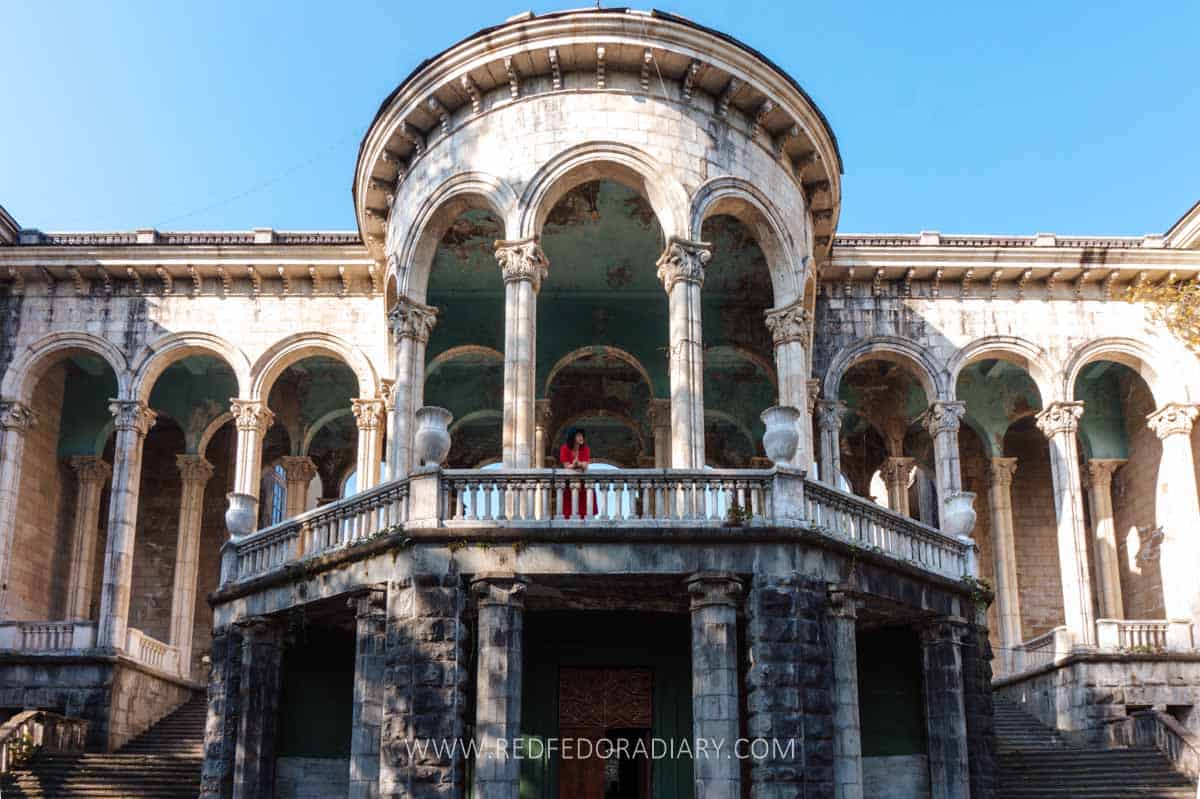
Since 2022, most sanatoriums have been sold on state auction, and it’s changing pretty fast, so now is the time to see them before they get a complete makeover.
This post gives detailed information on the history of Tskaltubo, how to get to Tskaltubo, how to visit these Soviet sanatoriums and bathhouses, and provides practical information with a map.
Disclaimer
This post includes affiliate links to products, which earn me a small commission at no extra cost to you. This helps to fund my blog and bring more authentic articles to you 🙂 Learn more
What are sanatoriums?
A while back, I met a foreigner in Kutaisi who didn’t quite understand what sanatoriums were in the Soviet times. He thought it was facilities for those with mental disabilities and was surprised that this was a popular destination in Georgia for tourists to explore. Therefore, if you feel the same, let me explain what sanatoriums were.
A sanatorium is a medical facility or resort that provides treatments and restorative care to people with various health conditions. Sanatoriums are typically located in favorable natural surroundings like mountains, forests, or near mineral springs.
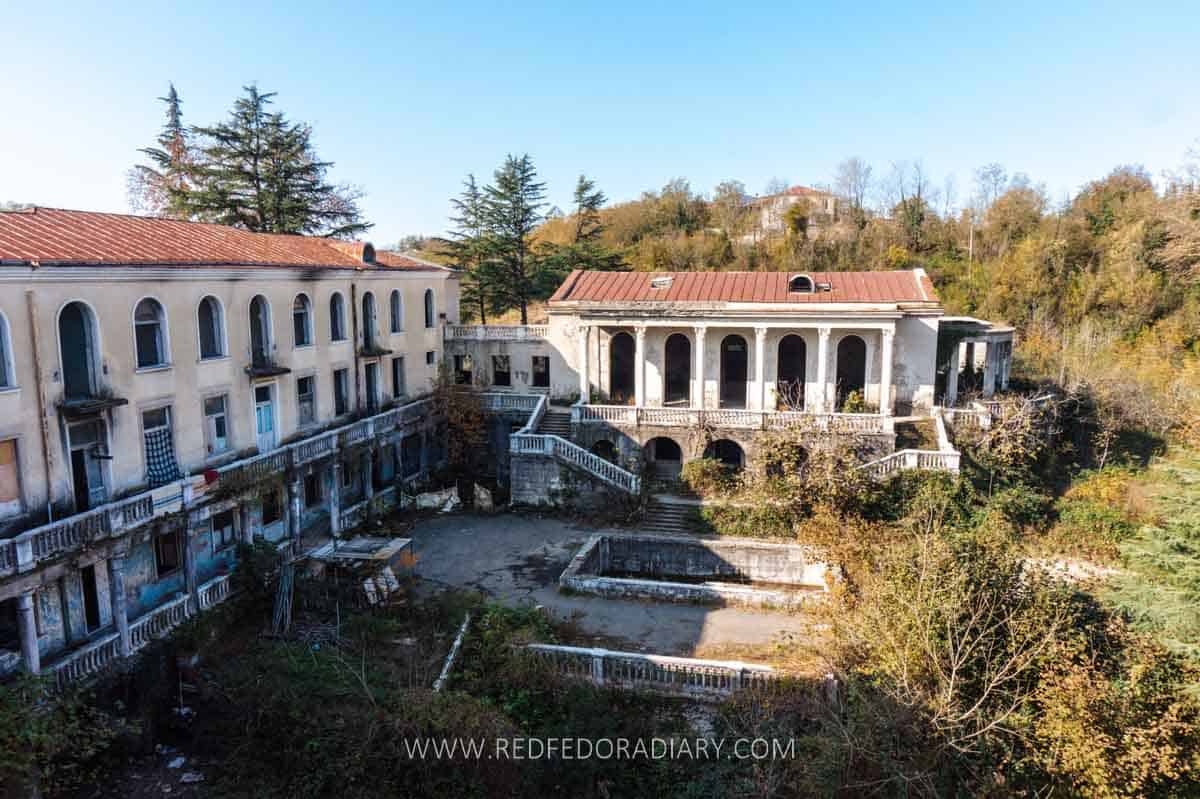
They offer a range of medical treatments, including balneotherapy (therapeutic bathing in mineral waters), physiotherapy, and other rehabilitative therapies. They aim to improve their guests’ well-being and overall health through medical interventions, rest, and relaxation.
Soviet sanatoriums were designed to cater to the needs of workers and the general population, offering affordable healthcare and recreational options. They were considered an integral part of the Soviet healthcare system, emphasizing preventive medicine and promoting overall well-being.
A brief history of Tskaltubo
Georgia’s healing mineral waters and sulfur springs have enticed visitors seeking rejuvenation and treating various diseases for centuries. When we became part of the Russian Empire in the late 18th century, Georgian natural spa waters got wide recognition leading to the establishment of Soviet spa towns like Borjomi, Abastumani, Sairme, and Menji.
Tskaltubo is home to a network of radon-carbonate mineral springs with natural temperatures ranging from 33-35°C. The water is crystal clear, soft, and has no smell. These springs are believed to possess therapeutic properties beneficial for the cardiovascular, nervous, and endocrine systems and treat various skin ailments, rheumatism, and arthritis.
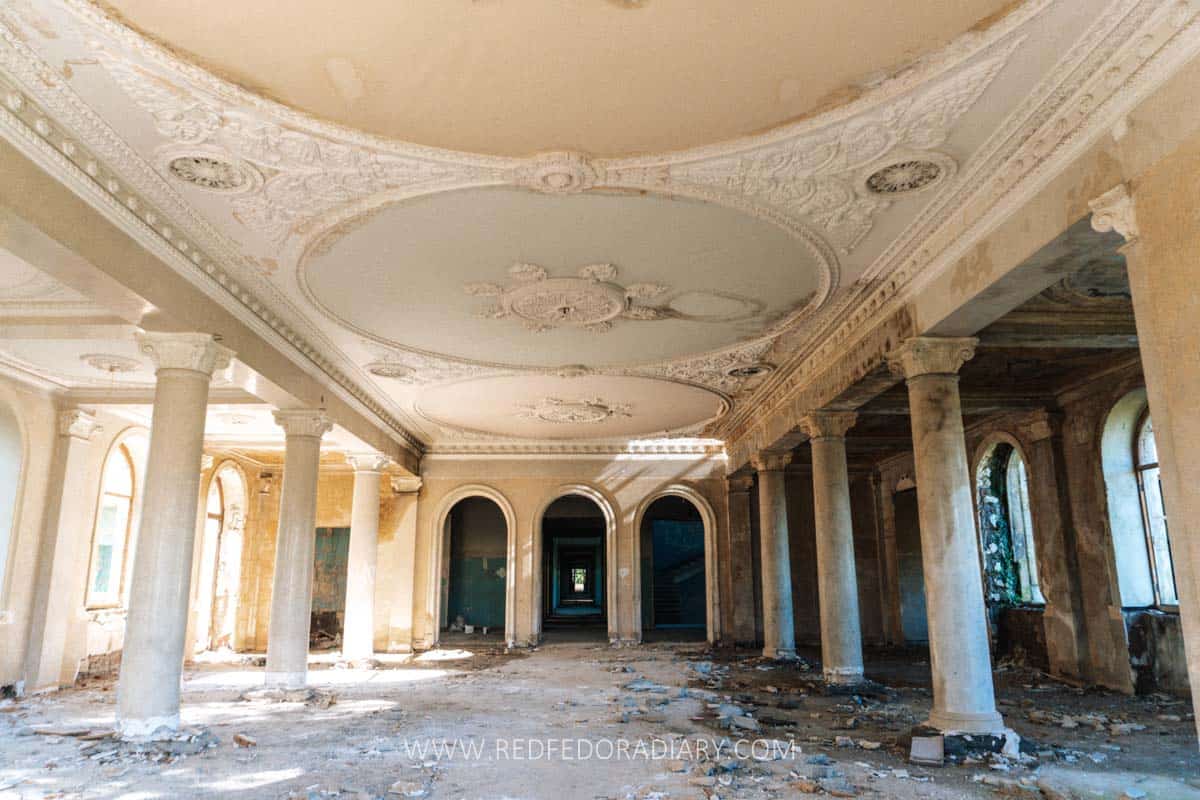
According to a Georgian historian, and scientist, Professor Nikoloz Berdzenishvili, the local population had information about the healing properties of Tskaltubo waters since ancient times. Tskaltubo was known as early as 7-9 centuries. These waters were especially popular during the reign of King Tamar and were part of the royal court. Historical sources testify that it was here that the warriors of King Tamar rested and were treated.
In 1913, a thorough chemical analysis of Tskaltubo healing waters’ natural properties was conducted, confirming its uniqueness. Tskaltubo became an official balneological resort in 1931. It gained the city status in 1953.
During the Soviet era, particularly post-World War II, Tskaltubo flourished as a thriving spa town among Georgia’s various wellness destinations.
Soviet-era Tskaltubo
Coinciding with this significant development, the story goes that Joseph Stalin, the then-Soviet leader, purportedly made his first visit to Tskaltubo in the1920s. There is not that much information on his first visit. Legend has it that he sought balneological treatment for his leg pain, prescribed by his doctor in Moscow.
Stalin allegedly returned to Tskaltubo for a second visit in the 1950s. In preparation for his arrival, the construction of this entire town commenced in January 1950, employing over 4,000 workers who toiled day and night to unveil the first bath house in December of the same year.
The famous Bathhouse N6, also called Stalin’s Bath because it was built specifically for him, opened in 1951.
During his stays, he had private quarters at the Soviet Union Ministry of Defence sanatorium, now known as Tskaltubo Spa Resort. He also had exclusive access to Bathhouse N6 and a summer house on a nearby hill. You can visit all of them; details are below.
Tskaltubo is one of the rarest resorts whose planning and development were carried out according to a scientifically proven original plan.
From the mid-1930s to the 1950s, Tskaltubo was in total development. According to the plan, balneological, sanatorium, residential, and recreation zones were established, with a large park in the center.
Tskaltubo spa resort had 22 sanatoriums, many of which are architectural works of art. More than 150 different types of leafy and coniferous plant cultures were artificially cultivated. Healing spring waters and nine bathhouses were surrounded by lush greenery – all this was arranged as an amphitheater according to the plan.
The mineral waters in Tskaltubo held significant healing properties but had a short lifespan, losing their efficacy within 3-4 minutes after release. As a result, they could not be bottled or pumped, unlike spring water in Borjomi. Consequently, only the spas within the designated “balneology zone” had direct access to the springs, limiting treatments exclusively to the facilities located within the park.
During its pinnacle, Tskaltubo attracted an impressive number of visitors, with up to 125,000 people from all corners of the USSR flocking to the town annually for their state-mandated rest and recovery.
There was a direct train from Moscow to Tskaltubo to transport citizens to their well-deserved rest. At the train station, buses with signs of each sanatorium’s name were lined up to bring the vacationers to their booked sanatoriums.
Although Tskaltubo held a prestigious reputation, it was not solely reserved for the elite. The benefits of Tskaltubo water were accessible to workers from all backgrounds, according to the provisions outlined in the USSR Constitution, which guaranteed every citizen the right to rest and leisure. Doctors would then give out fully funded vouchers for treatment for 14 to 21 days. My grandmother and one of her sisters were frequent guests of Tskatubo sanatoriums.
Tskaltubo after the Soviet-era
Following the disintegration of the Soviet Union in 1991, Tskaltubo faced a bleak fate. The once-grand cement structures were left deserted to succumb to the passage of time and became victims of theft and robbery.
Tiles, radiators, pipes, furniture, and any valuable or salvageable materials were stripped away, either used as firewood, repurposed, or sold in junk yards.
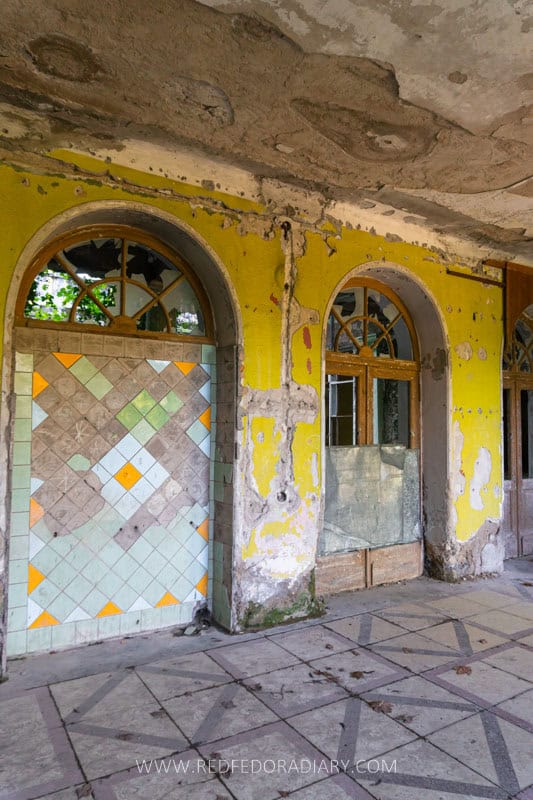
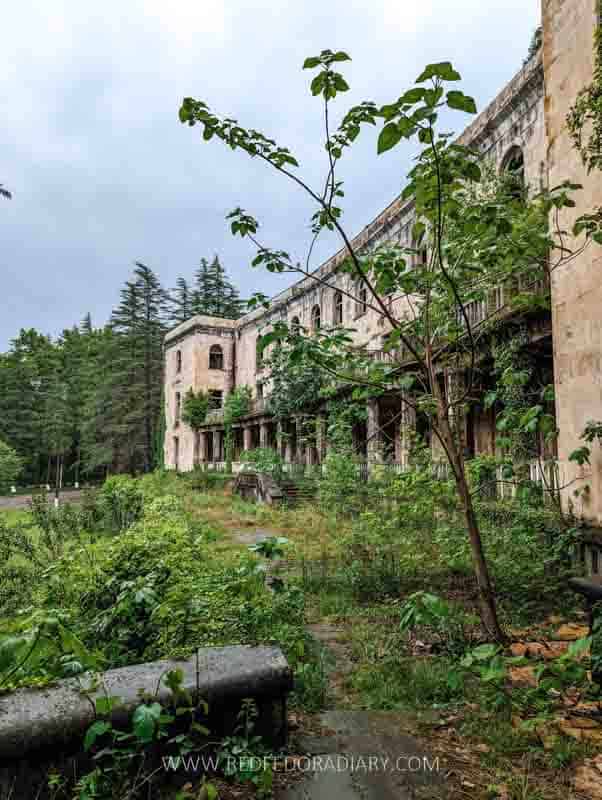
When the conflict in Abkhazia erupted in 1992 and lasted over a year, at least 200,000 were forced to leave their homes and find accommodation elsewhere in Georgia. Out of that number, around 8,000 internally displaced persons sought solace in Tskaltubo’s forsaken embrace. These individuals found “temporary” shelter within the extraordinary neoclassical ruins, and even after 27 years, some families still called these remnants of the past their home.
However, in 2023 most of these families relocated to new apartment buildings, paving the way for imminent renovation efforts to revitalize the area.
Tsaltubo now
In 2012-2013, several sanatoriums in Tskaltubo were bought by private investors and were then resold. In 2018, the government launched an ambitious project to transform Tskaltubo into Eastern Europe’s most prominent spa destination. However, the project did not materialize, and none of the sanatoriums underwent reconstruction.
In 2019, Bidzina Ivanishvili, a Georgian billionaire and former premier, offered to purchase all the sanatoria for a symbolic amount of 1 GEL and finance the stalled development scheme. Families residing in the sanatoriums would be relocated as part of this plan.
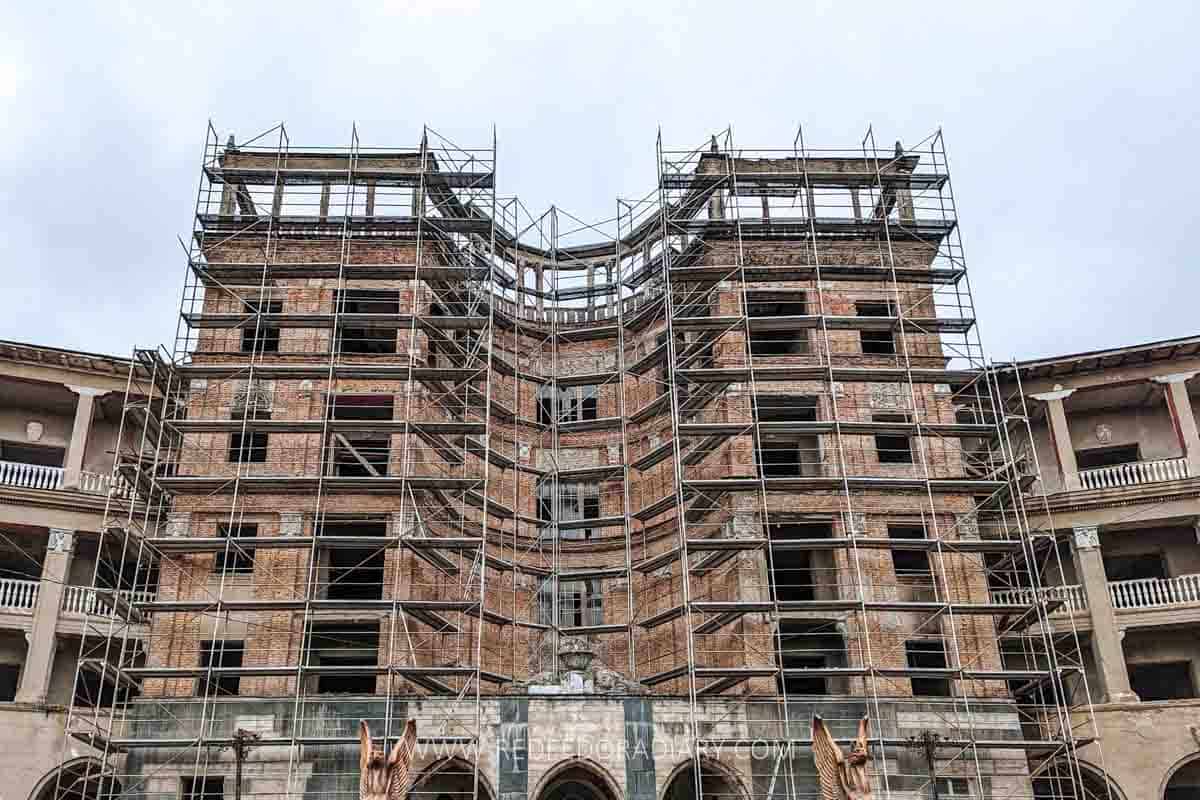
In the summer of 2022, discussions surrounding the revitalization of Tskaltubo gained momentum. The “New Life for Tskaltubo” initiative put 14 grand buildings up for auction, attracting interest from Georgian consortiums and private international investors.
From March 2023, several sanatoriums have been cordoned off with proper fences in preparation for upcoming renovation work. Families have been relocated from several of the larger buildings. Renovation is already underway at one of the sanatoriums.
Practical tips when visiting Tskaltubo
Tskaltubo town: the town itself may appear compact, but it is surprisingly big when it comes to exploring its sanatoriums and bathhouses. It’s an easy walkable city, but you’ll walk significantly during your visit. All the sanatoriums are located around a vast central park, making it easy to explore them on foot.
The time needed: this solemnly depends on which sanatoriums in Tskaltubo you want to visit. Visiting Tsklatubo as a day trip from Kutaisi is quite a popular choice. One full day is enough to see several sanatoriums that are must-visits. However, fitting everything in one day will exhaust you. Therefore, you’d need a day and a half or two full days to see everything I enlist below, including other sights beyond the bathhouses and sanatoriums.
Must-visit sanatoriums: out of 22 Soviet sanatoriums, only ten are worth exploring because of their architecture or mosaics: Aia, Sakartvelo, Medea, Shakhtiori, Gelati, Tbilisi, Metalurgi, Tskaltubo Spa Resort, Imereti and Savane.
Two of those sanatoriums (Iveria and Shakhtiori) are private property now and have a fence around them. As for 2023, you can’t sneak in any of these two anymore.
Sanatorium Tbilisi is now undergoing major reconstruction works. While you can’t wander the premises, you can walk up close to see the works underway.
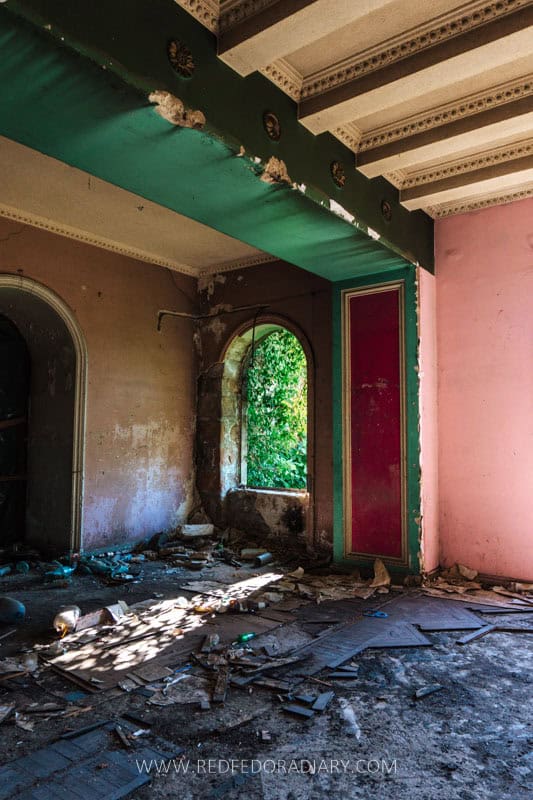
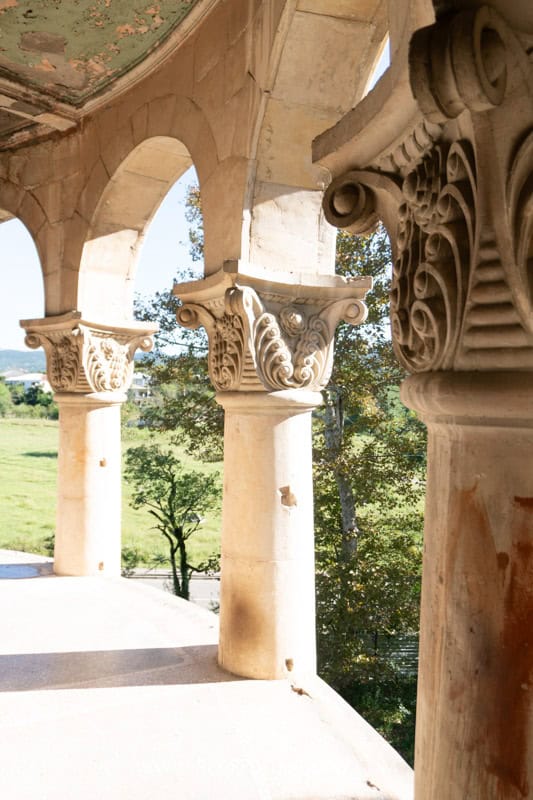
Bathhouses: only two out of the nine remain active: Bathhouses N6 and N2. Others are empty, covered in greenery, and crumbling.
Safety when urbexing: any activities you take in Tskaltubo are done at your own risk. Many of the buildings are dilapidated, making walking around feel unsafe. Be cautious where you step, and always look under your feet and above your head.
Abandoned sanatoriums often have litter, including broken glass. I advise you to wear closed shoes and be careful when walking up or down the stairs.
Like anywhere in Georgia, Tskaltubo also has stray dogs. Typically they are pretty friendly and unharmful but be aware of territorial dogs.
Generally, it is a safe town to explore, but like elsewhere, be cautious of your surroundings if traveling alone as a female. I’d recommend finding a travel buddy when exploring the remote roads of several sanatoriums.
Minding the residents: remember to respect families living within the sanatoriums. They are pretty friendly and used to tourists, but you are still entering someone’s ‘property.’
Avoid venturing into clearly inhabited areas, and do not unintentionally intrude upon someone’s living space.
Not all sanatoriums bought by investors have fences around them, so it might be challenging to understand which ones you can visit and which not, as things are changing here.
All the details of each sanatorium in Tskaltubo are below based on my experience as of May 2023, but exercise a general rule when you arrive. By all means, avoid transpassing.
How to get to Tskaltubo
Getting from Kutaisi to Tskaltubo
Tskaltubo is around 15km from Kutaisi, making it easily accessible by taxi and public transport.
You can order a taxi through the Bolt app from the city center. The journey will cost you approximately 13-20 GEL.
Alternatively, there are two marshrutka options. Marshukta number 30 is the most convenient one departing from the end of the Red Bridge. They depart daily every 15-20 minutes from 8 am to 7 pm. The ticket costs 2 GEL.
Marshrutka 34 departs from Kutaisi Central Bus Station every hour between 9 am and 6 pm. The price is the same – 2 GEL. You’d need to take bus number 1 to get to the Bus Station. The city bus costs 60 tetri with Georgian bank cards or a Kutaisi transport card. International cards also work, but they might charge you over 60 tetri.
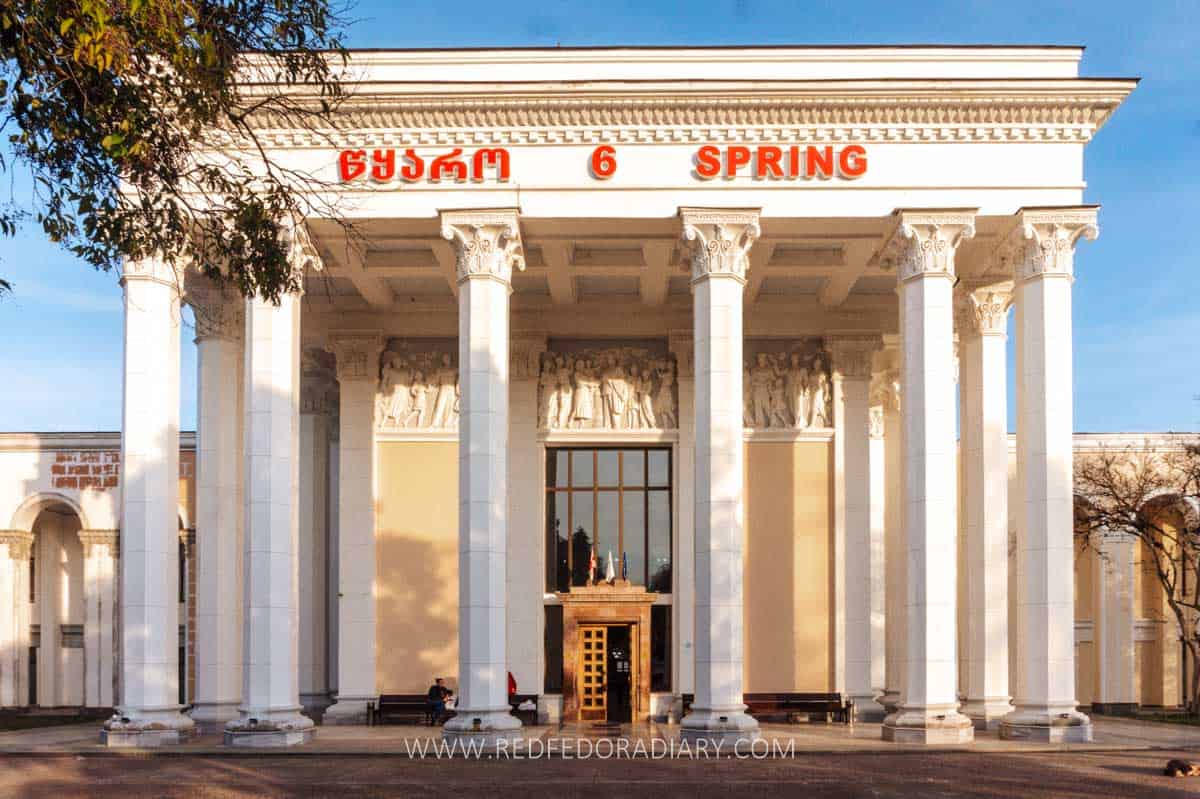
Returning back from Tskaltubo to Kutaisi
The marshrutkas follow Rustaveli Street in Tskaltubo along the park’s eastern side. You can hop off anywhere you’d like to start your exploration.
To return from Tskaltubo to Kutaisi, you can hail the marshrutka on the same eastern side of the park but on the opposite side of the road.
Renting a car or getting a transfer
As I mentioned earlier, visiting Tskaltubo is the most convenient day trip from Kutaisi. There are no direct connections between Tbilisi and Tsklautbo, plus the far location makes it quite tiring to travel from Tbilisi to Tsklatubo.
For more flexibility, you can rent a car in Kutaisi to visit all these sanatoriums or get a private transfer. For renting a car, I recommend Local Rent for its affordable prices. Gotrip.ge is a personal transfer service with a driver offering reasonable prices and unlimited stops within the journey.
Tskaltubo Map
The locations of Tskaltubo sanatoriums are not secret. All of them are pinned on Google Maps, but I still decided to create a list in Google Maps that you can save for later use.
Since only some roads or trails are marked on Google, turn on the satellite view to find pathways between those sanatoriums and bathhouses.
Hunting down abandoned Soviet sanatoriums in Tskatubo
This section will provide detailed descriptions and helpful tips for visiting 16 sanatoriums/hotels, five bathhouses, and a research institute building in Tskaltubo.
Sanatorium Sakartvelo
You can easily spot Hotel Sakarvelo from the road when entering Tskaltubo from Kutaisi, with its typical Soviet architecture and a sign still on its rooftop.
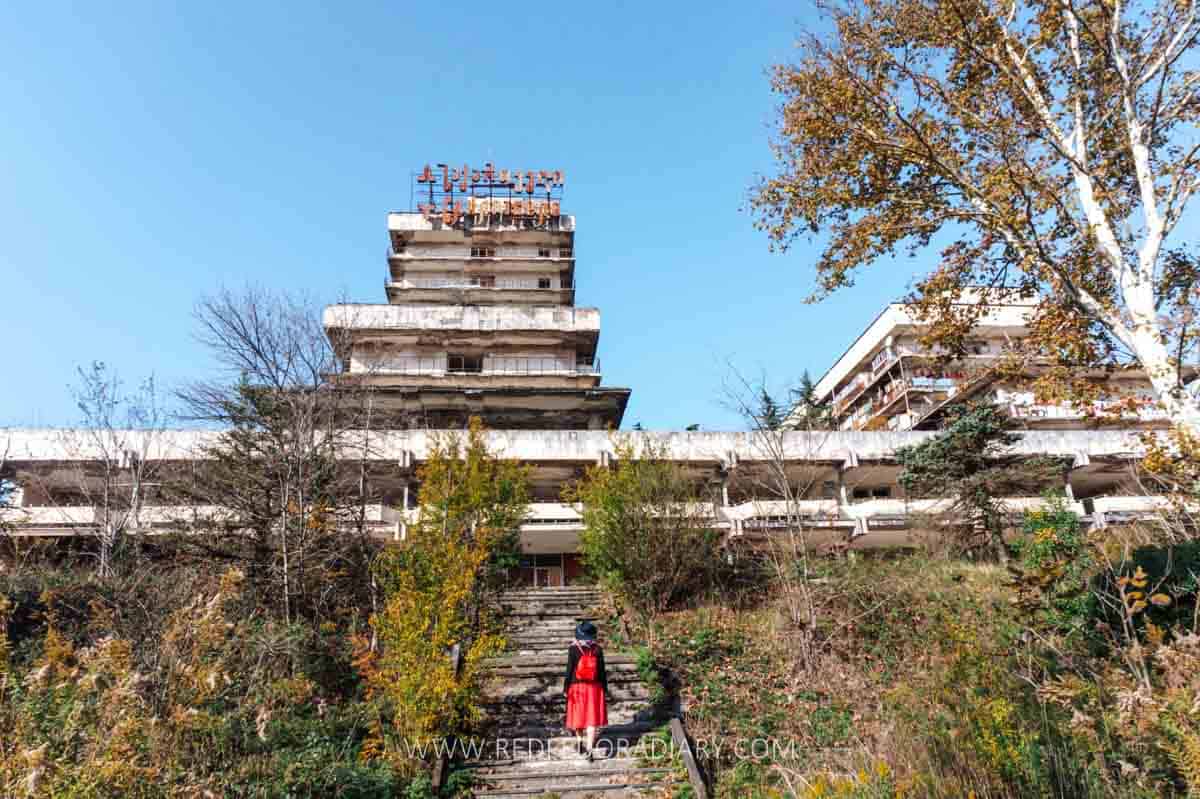
Sanatorium, constructed in 1970, has been transformed into residential housing. The highlight of Sakartvelo is the well-preserved mosaic on a wall and the indoor fountain.
It’s fascinating how this vivid-colored Soviet mosaic has withstood this sanatorium’s time and severe conditions, with water dripping from the roof for many years.
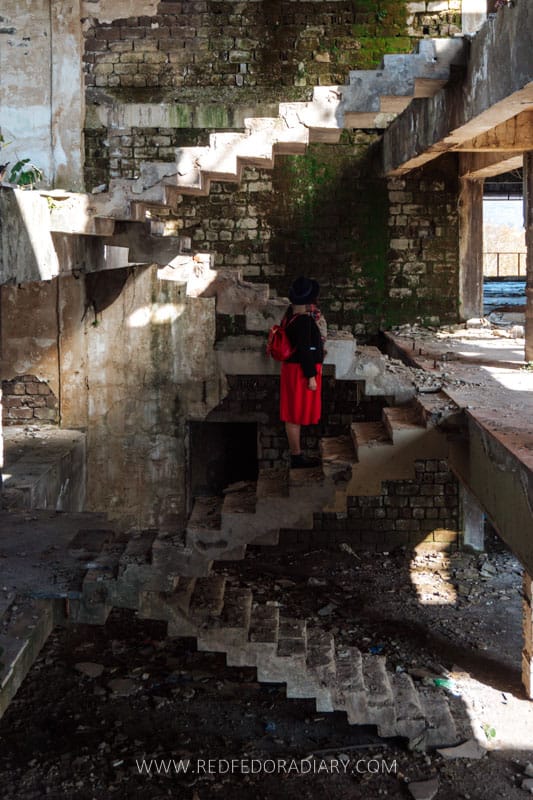
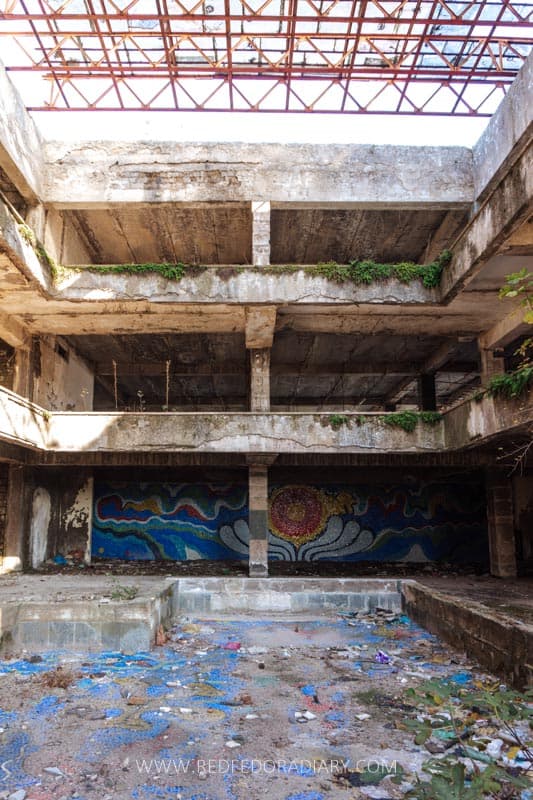
The concrete staircase is also quite interesting to photograph, as is the overhead view of the fountain with concrete floors with plants taking over.
Sanatorium Medea
Hotel Medea is my favorite one of all. You see and feel the grandeur of this sanatorium the moment you look at it from a narrow path leading to the complex.
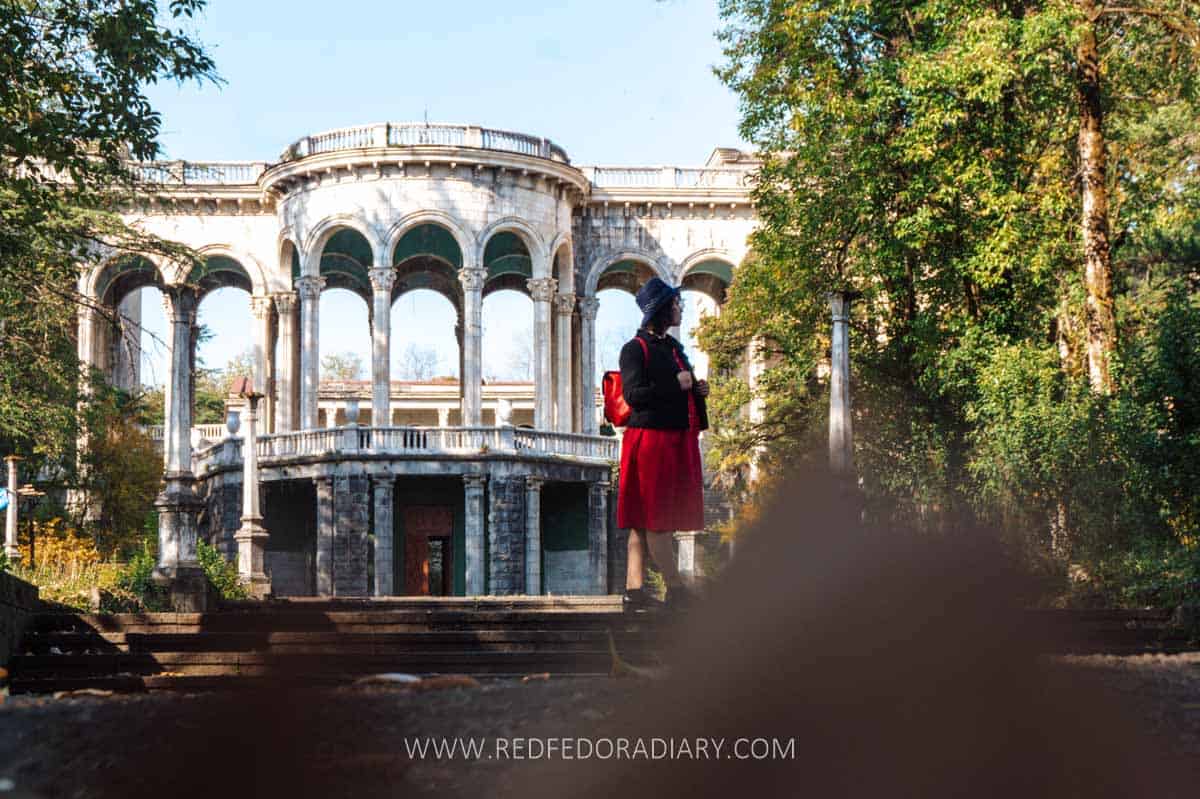
You’ll be even more surprised once you walk up the stairs to see marble-covered, Roman-style columns with typical carvings. Even in decay, it still mesmerizes you right away. Looking at those columns with the turquoise-color ceiling, I can only imagine how gorgeous it was years ago! And no wonder it’s also the popular spot for newlyweds to take photos.
Built between 1957-1962, it consists of 6 buildings of different sizes and floors connected to each other. From the colonnaded terrace, you can see its inner courtyard and a remnant of a central pool.
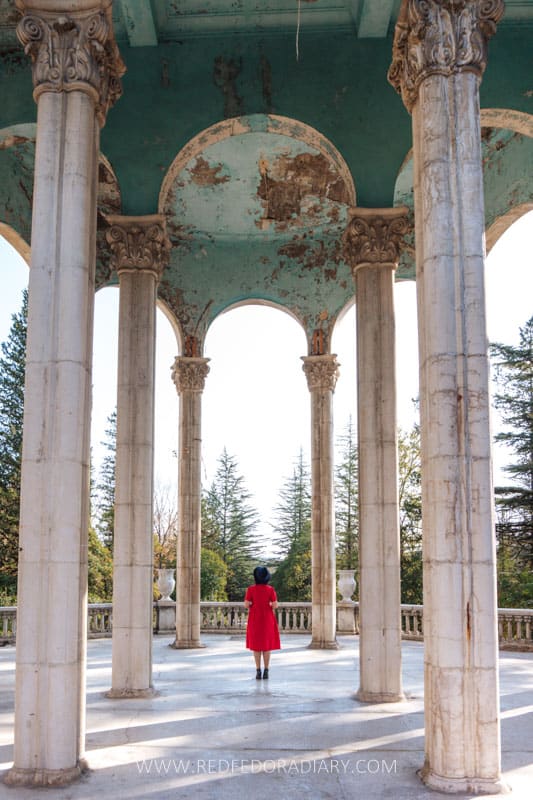
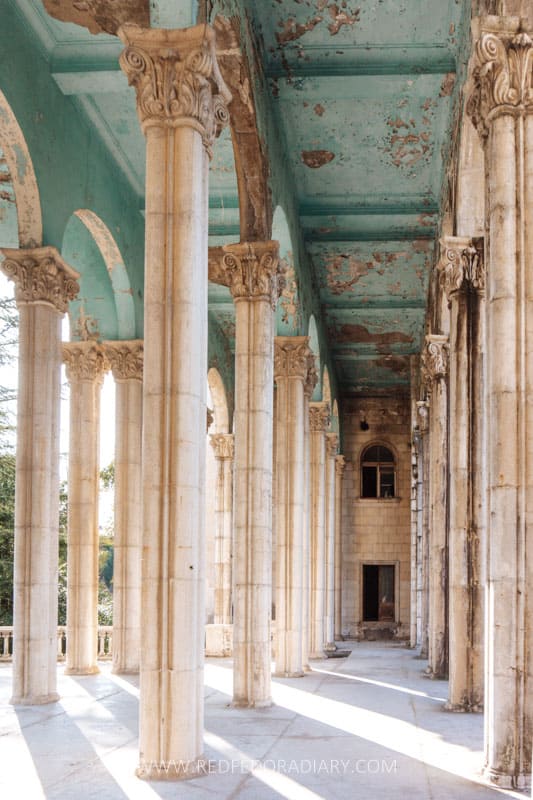
I never wandered through the inhabited floors of Medea sanatorium. I have only walked through the main terrace and walked up the rooftop from one of two side entrances from the terrace. Remember to walk on the west side of the sanatorium to see a fountain in the garden with somewhat intact sculptures.
2023 update: Sanatorium Medea was also put on auction in 2022. There is no fence or a guard, and I easily visited the place. While the majority of the former residents moved out, there are still a handful left.
Sanatorium Metalurgi
Metalurgi, or Metallurgy in English, is another beautiful sanatorium in Tskaltubo that’s in better shape than others.
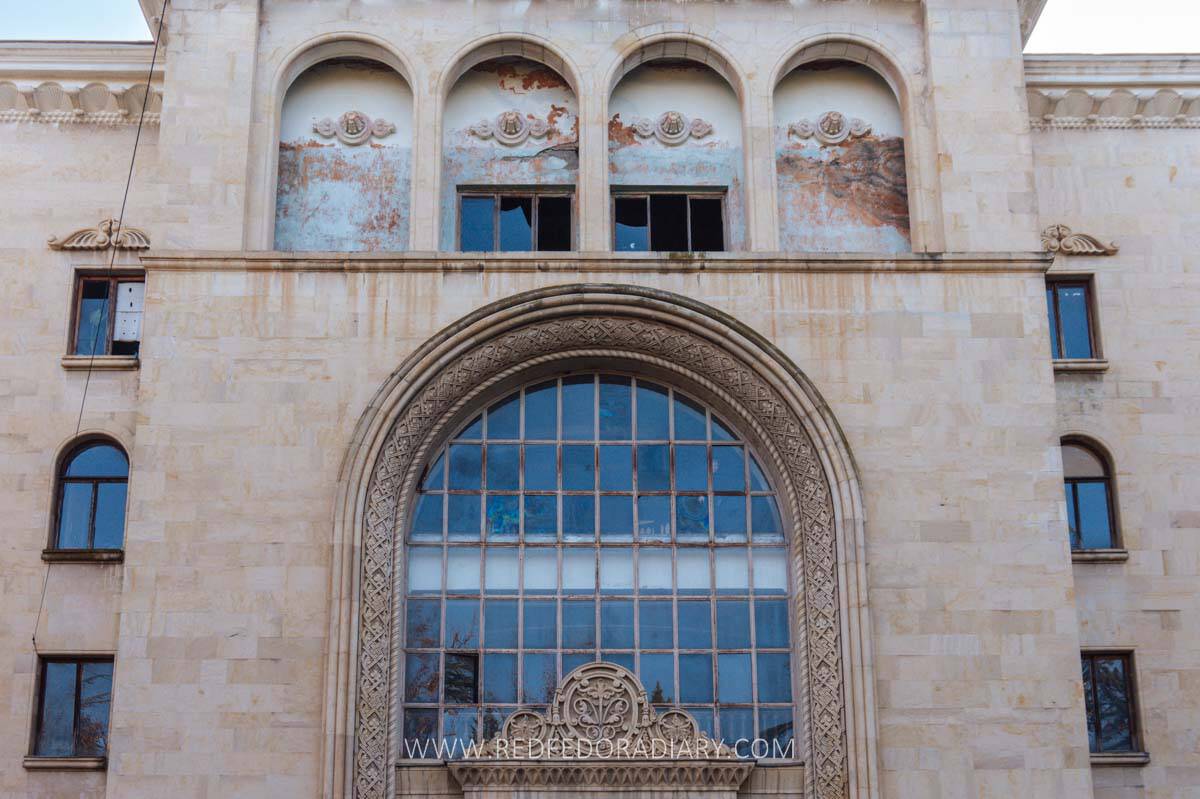
One can easily envision its former glory days when it served as a retreat for the hardworking metal workers from the Ferroalloy Plant in Zestafoni and the mines in Chiatura.
The sanatorium encircled with dense forest, used to have a grand gate entrance. The two columns of the gate remain at the entrance guiding you toward the building.
The facade of the sanatorium features arched glass windows and beautiful decorative stonework. Once you step inside, the grandeur of this once-popular recreational spot greets you instantly.
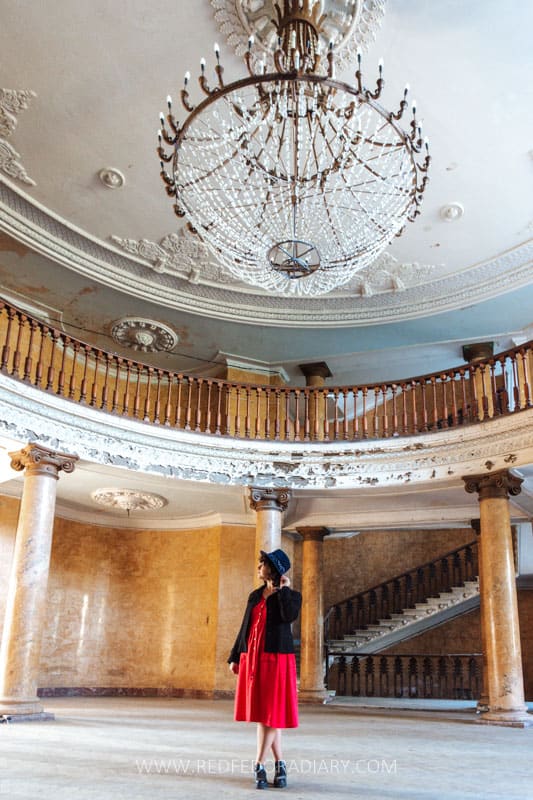
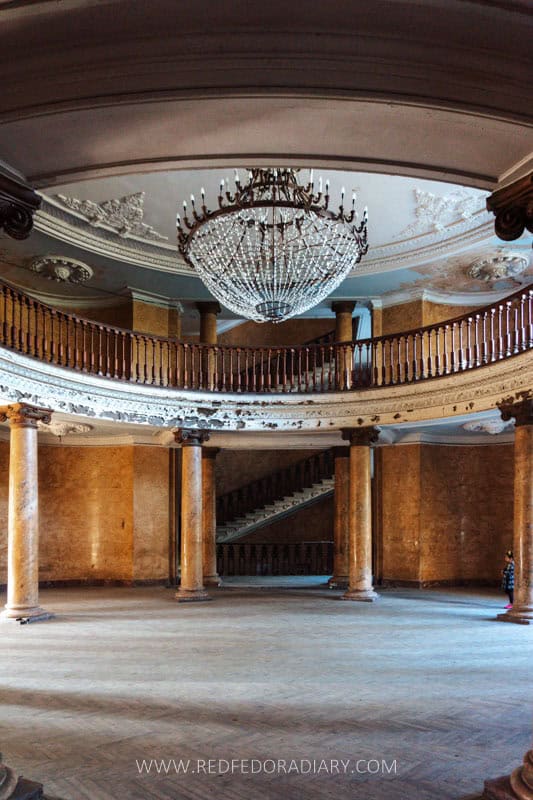
The original decoration and curved wooden fences surrounding the mezzanine opening are impeccable, complemented by a colossal chandelier suspended in the center.
The wrought iron work on the staircase railing leading to the second floor is impressive, as are the wall-carved decorations next to the elevators. I especially love the chair in front of that arched window on the second floor overlooking the front yard.
The former large concert/theater hall no longer exists, and the room is locked.
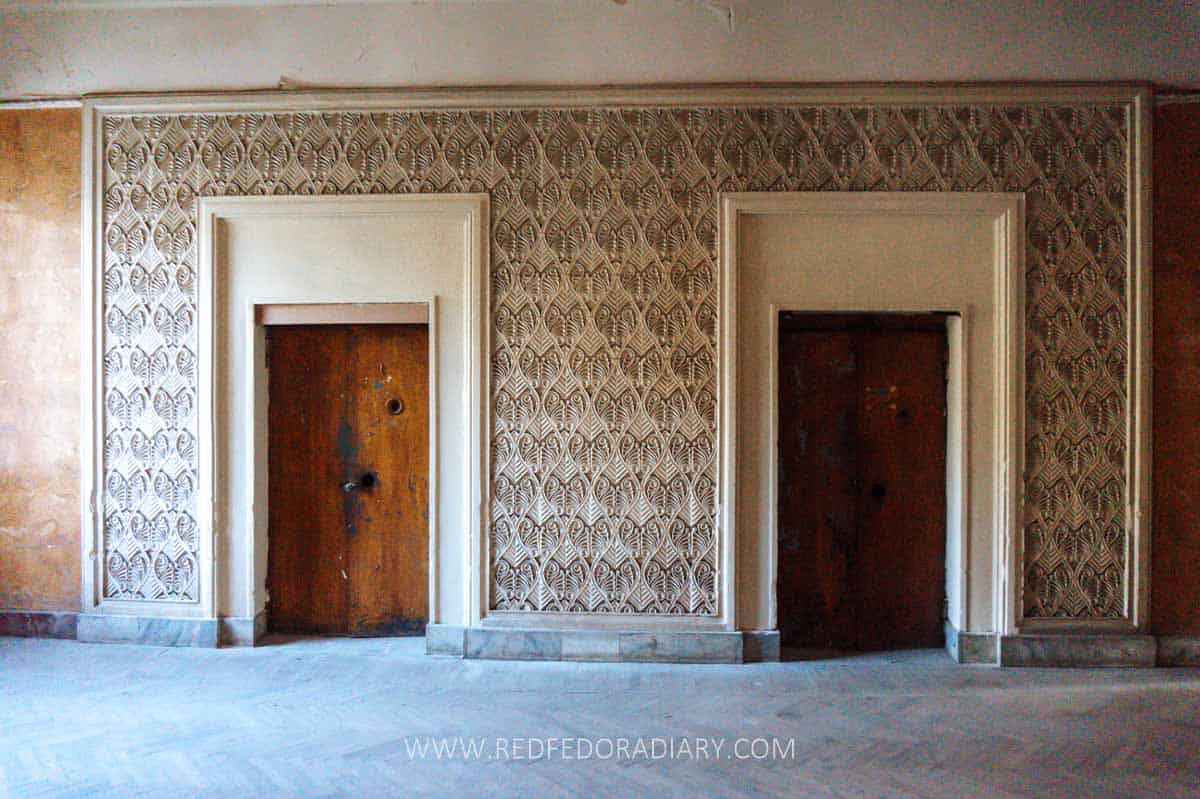
Today, many families still live here.
2023 update: I have heard that a lady asks for money to enter the sanatorium, see the entrance hallway, and tour the premises. On my last visit in May 2023, I haven’t seen anyone, though. Maybe because it was late afternoon?! Not sure.
Sanatorium Tbilisi
Sanatorium Tbilisi, constructed between 1950-1951, is a prominent seven-story building designed in the “late Stalinist” style.
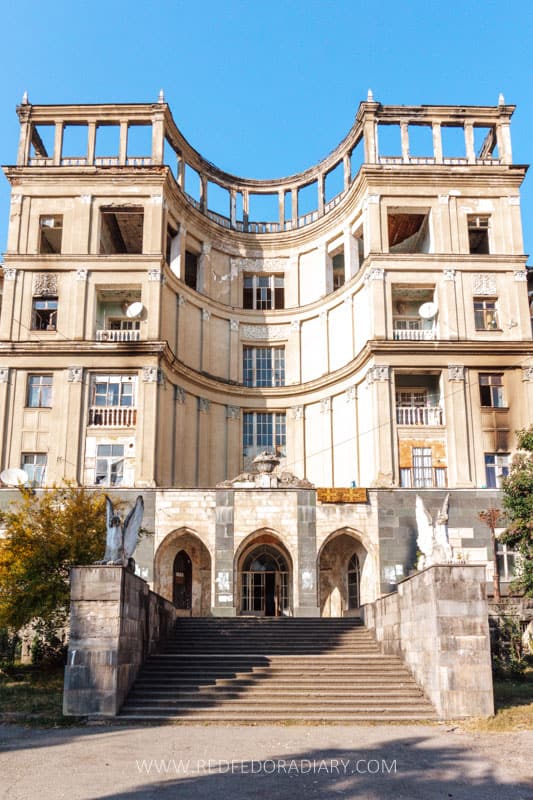
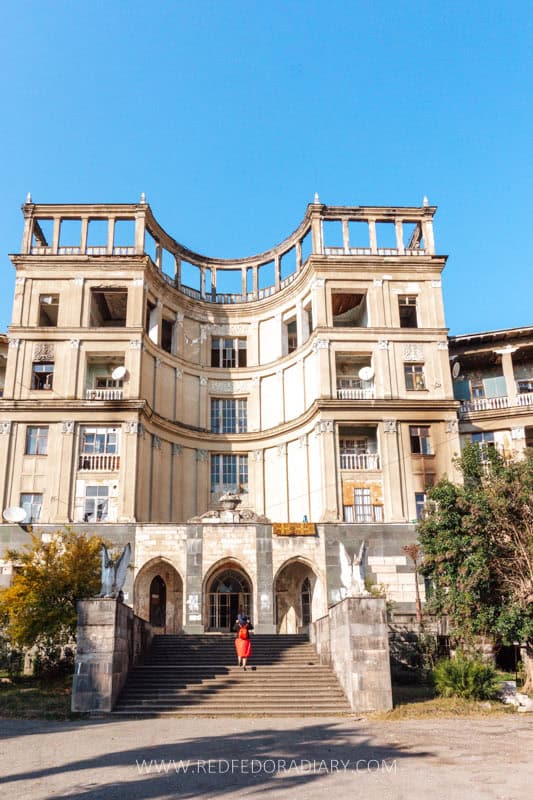
Pay attention to the balconies featuring facial sculptures of men and women. Upon ascending the stairs to the front entrance, a pair of winged mythical Griffins greet you.
The entry hallway opens into an inner courtyard shrouded by lush vegetation of lichen, plants, and ivy. I absolutely loved this tiny oasis within the crumbling building.
On the left side of the building towards the road, when looking at the main entrance staircase, the building has a bas-relief sign of Tbilisi Sanatorium.
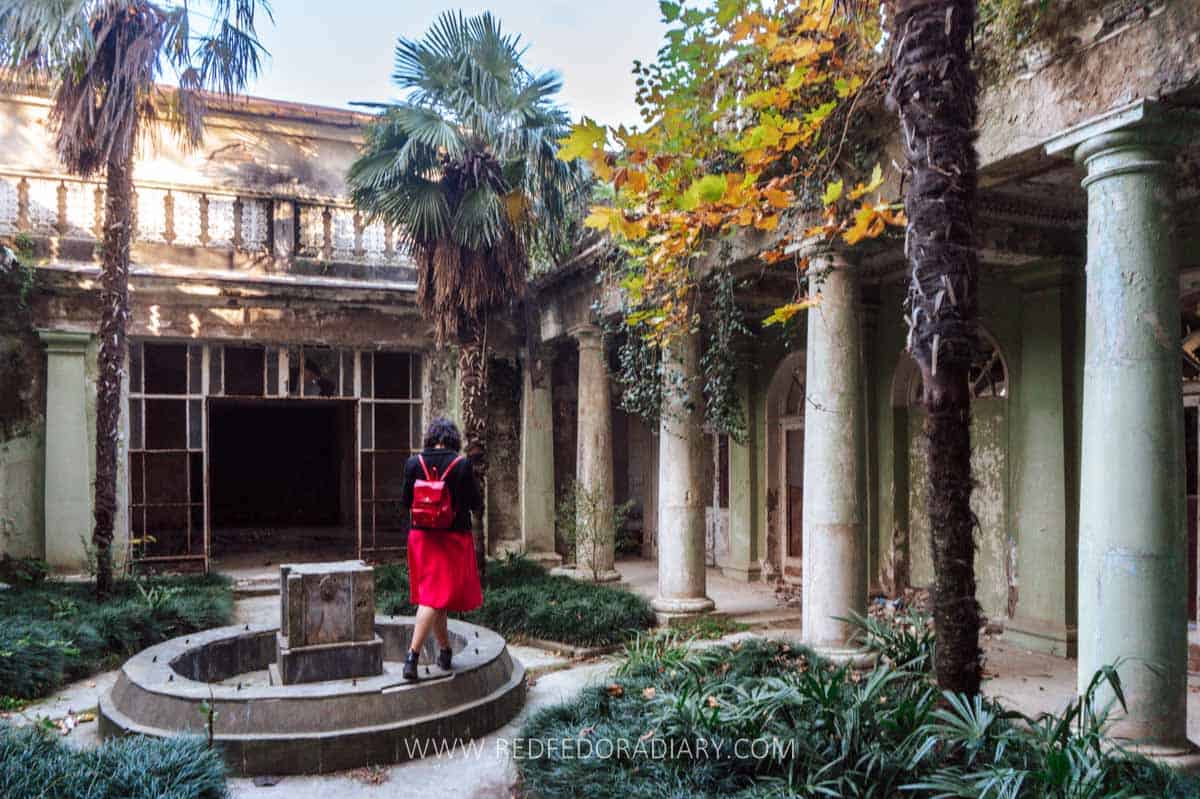
According to one Georgian website, the sanatorium has a form of the open-wing bird if looked at from above. However, I can’t confirm that, unfortunately.
2023 update: Sanatorium Tbilisi is the only one under construction now compared to other sanatoriums. As of May 2023, significant progress has already been made – a newly constructed fence now surrounds the property, and the facade is being meticulously restored. The Griffins have been restored and bronzed, while the sculptures above the balconies and the bas-relief signs remain.
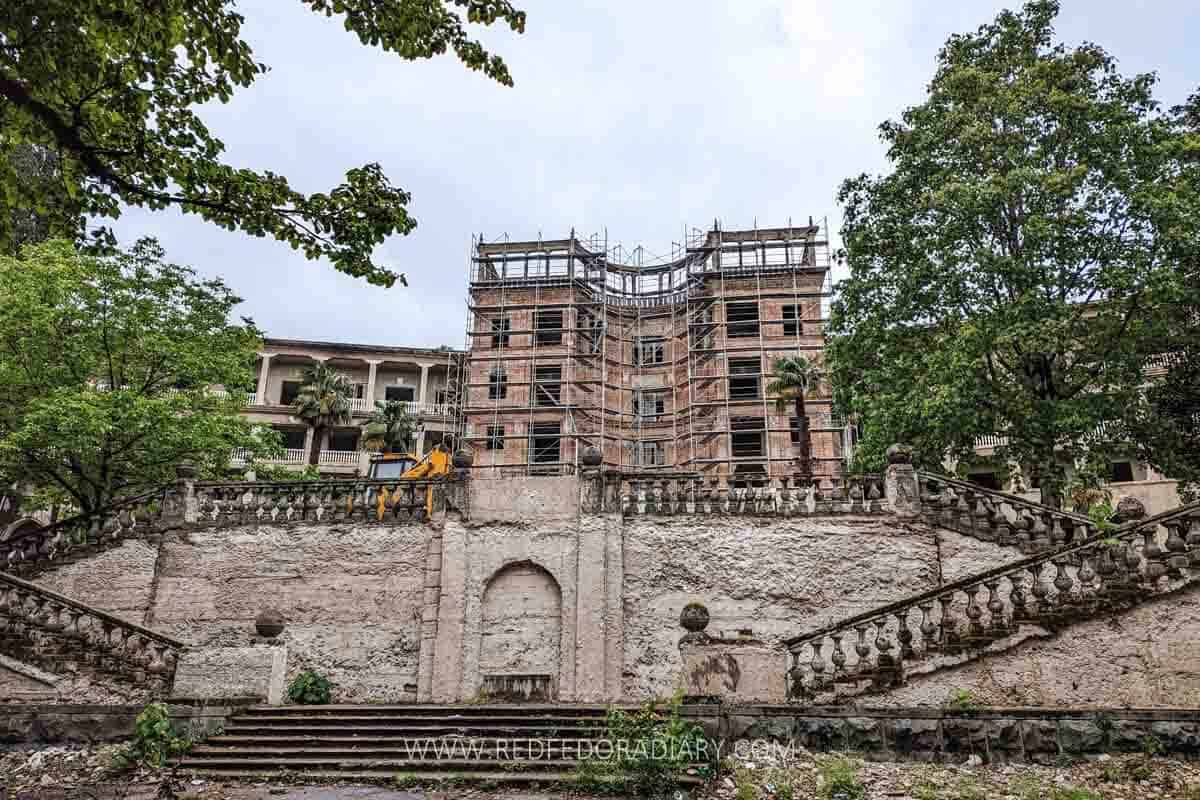
As the construction is in full swing, there are workers around the premises all the time, but they were friendly enough to allow me to take pictures and ask them questions. Note that going inside is not allowed anymore.
According to the workers I have talked to, the investor plans to keep the sanatorium’s original image and turn it into a hotel. Out of 400 rooms, now the brand new hotel will have 125. But as I got from the conversation, this might still change.
Sanatorium Gelati
Sanatorium Gelati was built between 1953-1964 and named after Gelati Monastery, today’s UNESCO World Heritage Sight close to Kutaisi.
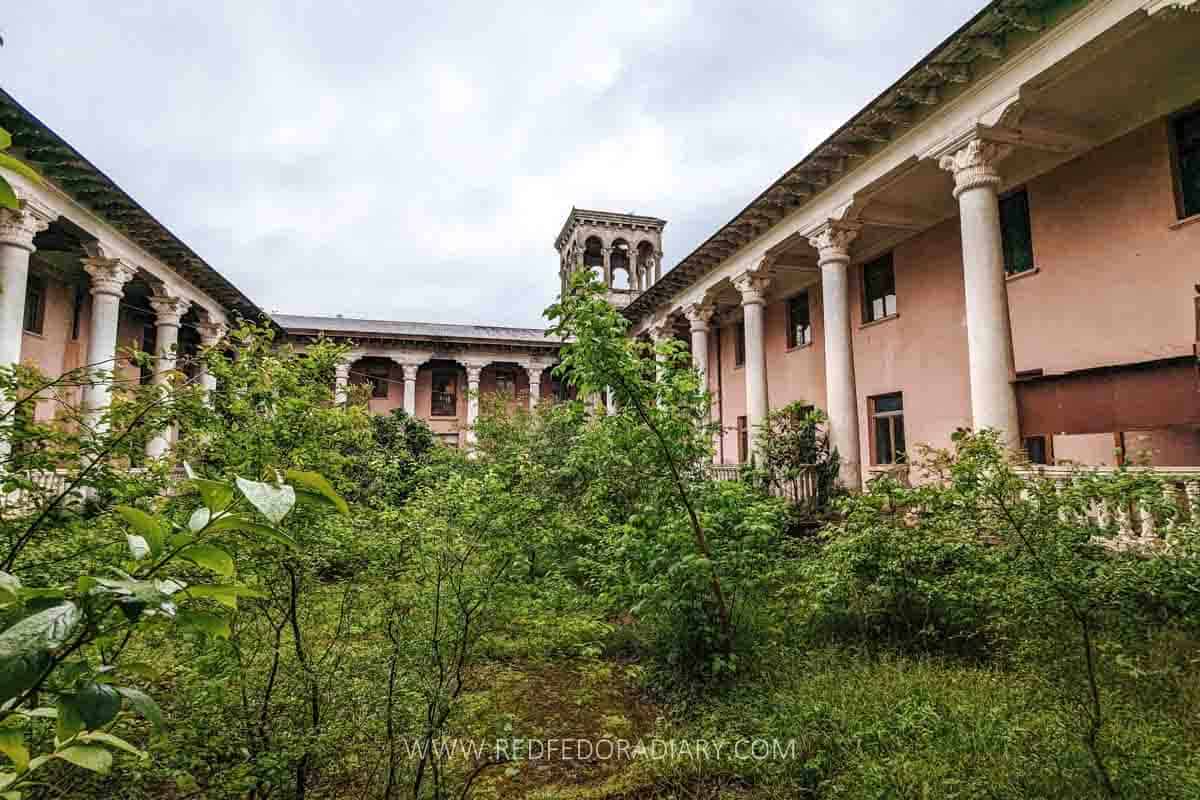
Typical Soviet-style Belvedere raising above the roofline is noticeable when you get closer to the building. The entrance and the staircase leading to the second floor are dark and uninviting. However, it leads to a concrete rotunda which most likely served as a concert hall.
On my first visit to Gelati, I felt unwelcome, so I walked around quickly to avoid unpleasant encounters with residents. Therefore, I haven’t explored the area much, and every time I returned to Tskalutbo ever since, I tried to avoid going there.
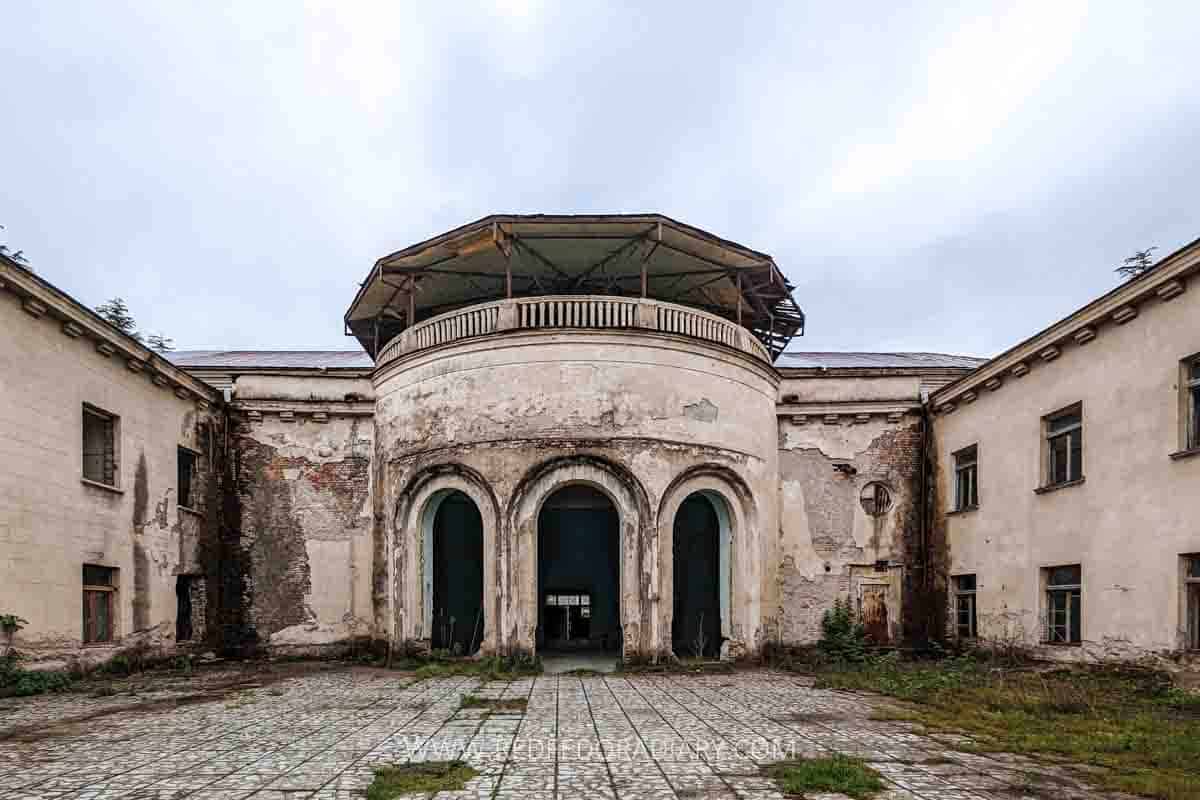
2023 update: as of May 2023, when I decided to visit the sanatorium Gelati, it felt empty and spookier than before. I stared at the facade for a while to understand if families got relocated or not. I haven’t heard a sound or seen a sign of anyone living there. However, there was no fence, and I could go inside the building for another quick peek.
Sanatorium Shakhtiori
Shakhtiori or Meshakhte is more glorious than any other sanatorium in Tskaltubo. The word Shaktiori or Meshakhte in Georgian means ‘miner.’
Constructed in 1952, it used to be a fashionable and luxurious sanatorium to stay for the elite of that time. It is the largest and most impressive building in Tskaltubo.
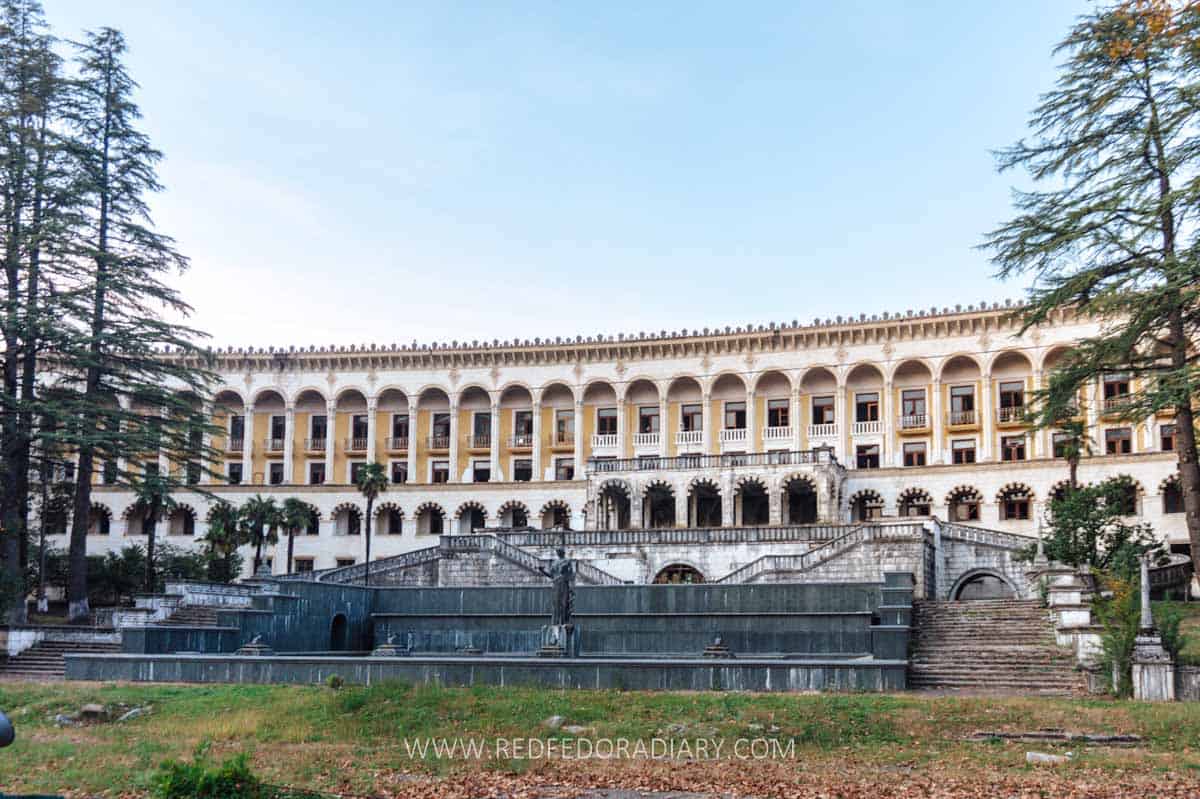
The front facade boasts a massive fountain with a female sculpture, towering palm trees, symmetrical stone staircases, and rows of infinite columns adorning every balcony.
Under private ownership, Shakhtiori has been fenced off and guarded for many years. This is the only sanatorium in Tskaltubo I haven’t been inside despite my attempt every time I return. I have only seen it in pictures.
As it’s fenced off, all you can do is peek inside the courtyard from the fence and admire its facade. The best spot to look beyond the fence is from the central entrance at Rustaveli Street, right from the suspended bridge over Tskaltubostskali.
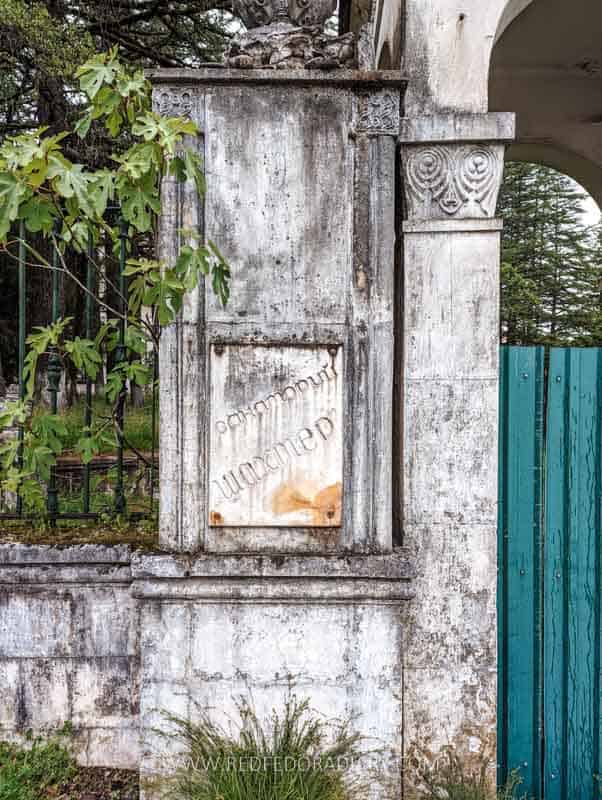
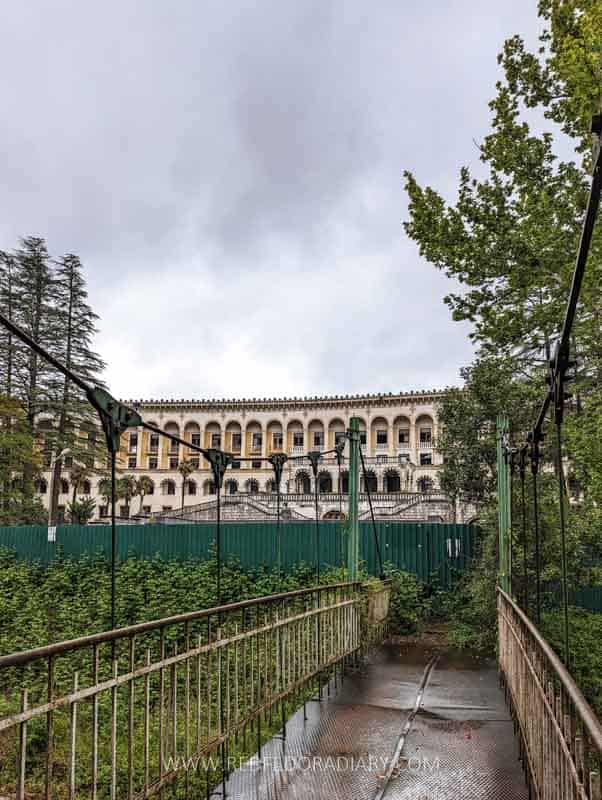
Walking around it on the Tskaltubo-Khoni side, you’ll notice the name carved on the stone in Russian, saying “Sanatorii Shakhtior”.
2023 update: the sanatorium still has a fence and a guard. He saw me peeking inside and came out to say hi and ask if I needed anything, but he didn’t let me in. Although, I have seen photos and videos on Instagram of people going inside after my last visit. I guess the guard doesn’t like me, or he favors foreigners.
Sanatorium Iveria
Iveria is my second favorite Soviet sanatorium in Tskaltubo, with its gorgeous interior. Built in 1962, it has a typical Soviet-style facade, and you won’t even imagine its inner beauty.
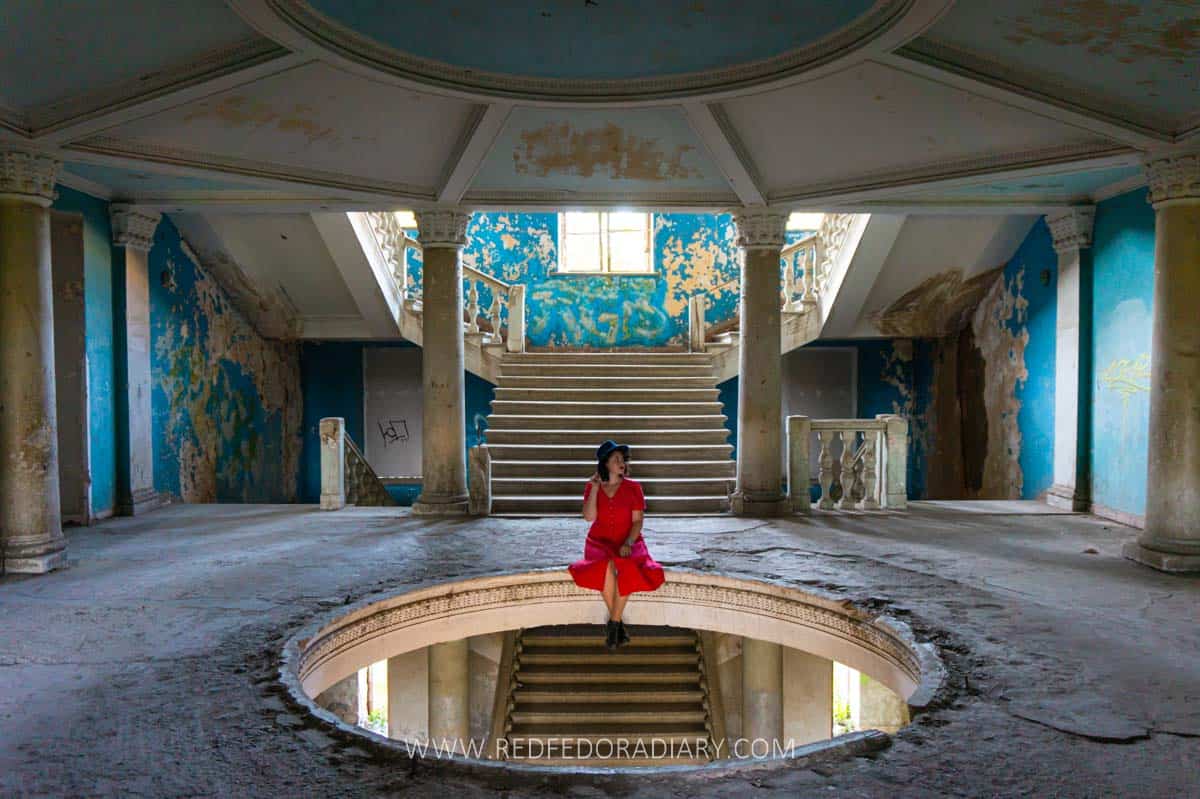
The main entrance hall is distinguished by its blue walls and a sizable round opening in the ceiling that provides a glimpse of the mezzanine floor that was initially intended as an internal balcony. After the surrounding balustrade collapsed, the hole was left like this.
In 2017, Sanatorium Iveria was sold to investors with plans for demolition and the construction of a new hotel in its place. The security fence without the guard had a few openings during my visits, providing easy access for us to wander the complex.
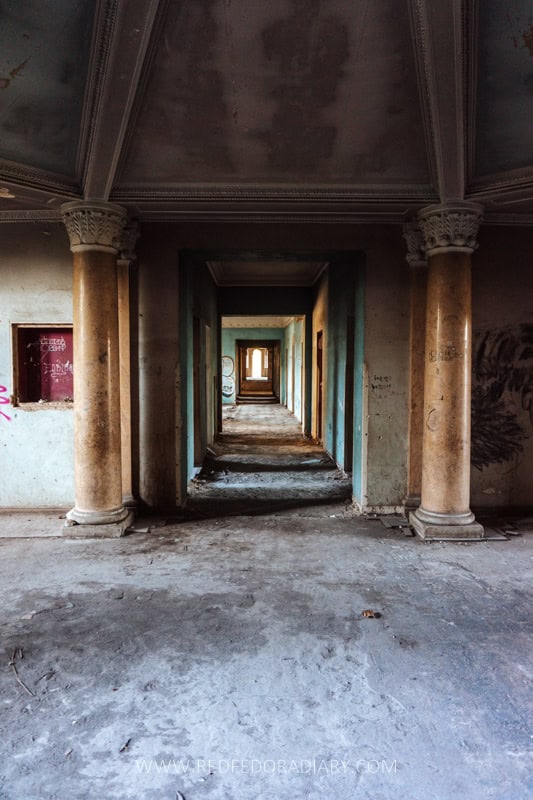
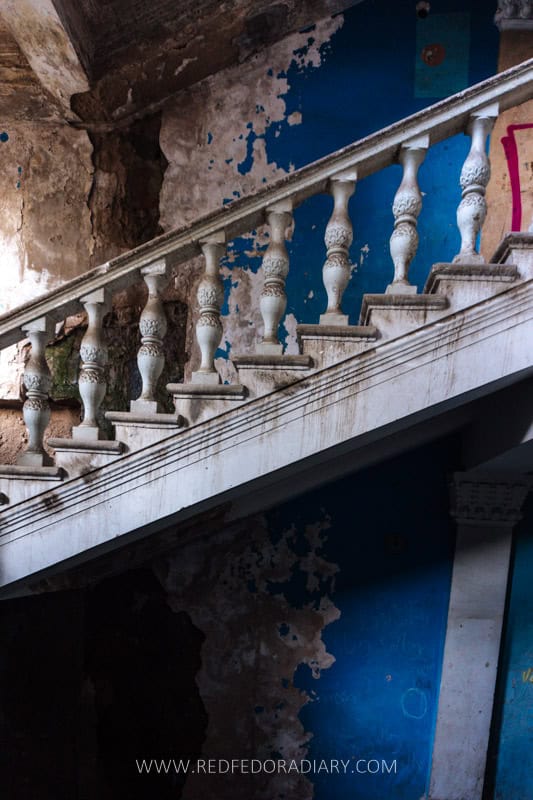
2023 update: during my last visit in May, I discovered that the fence had changed and the openings sealed, making it inaccessible. You can stand on top of the pillars on the street to see the facade of the building.
Sanatorium Imereti
Sanatorium Imereti is another massive complex built between 1950-1961. This impressive building features a gorgeous double staircase from black stone. Unfortunately, the decorative columns that once adorned the stairs now lie fragmented.
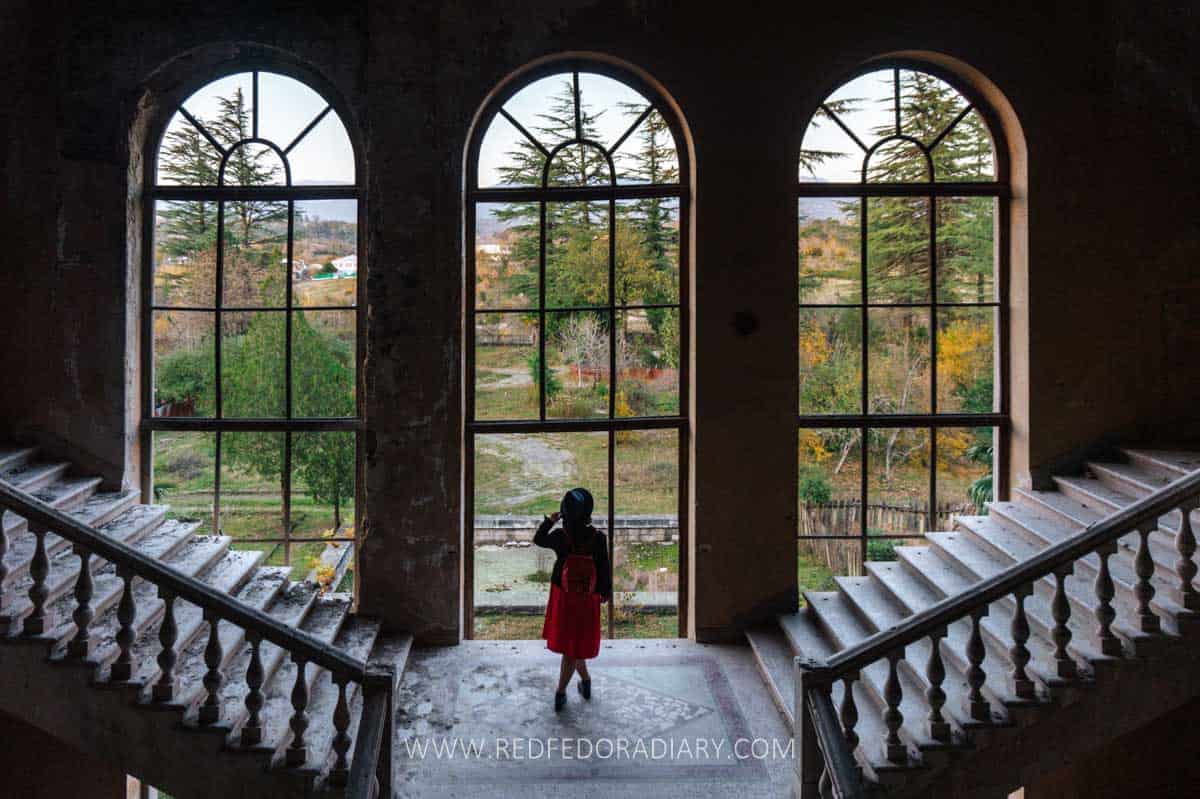
It has an arched gallery and massive columns on each floor. The ground floor, or what might have been the foyer, has an oval shape leading to large staircases and tall floor-to-ceiling windows, making a great photo spot.
The courtyard of a once colossal building is now covered in greenery, making it slightly hard to walk around. Walking in from the yard, you’ll find another beautiful circular staircase on either side of the building.
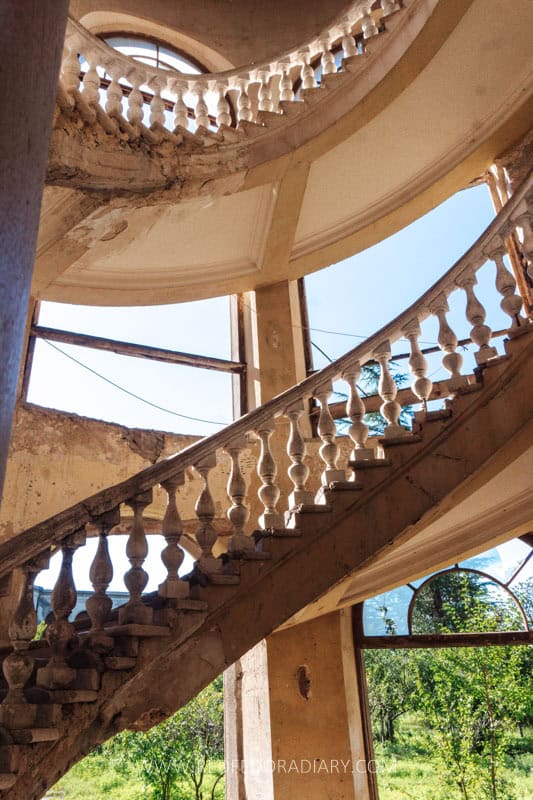
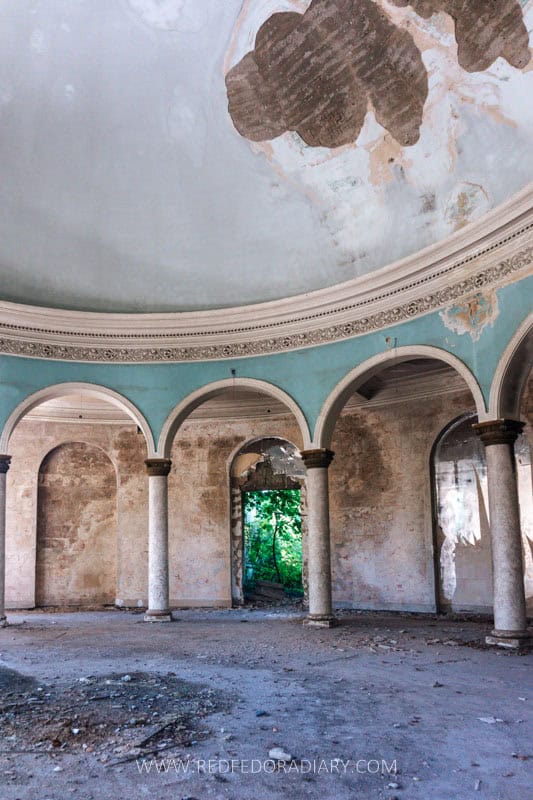
A spacious dome on the left side of the building has traces of its great decorative works. It also has a small round skylight and massive arches that lighten the room.
The architect behind the Sanatorium Imereti was a famous Soviet-era architect Aleksi Meskhishvili. A few months back, TBC Bank held an exhibition of his lifelong masterpieces. The maquette of sanatorium Imereti was also present. Initially, it was supposed to have a tower, but it never came into the initial plan.
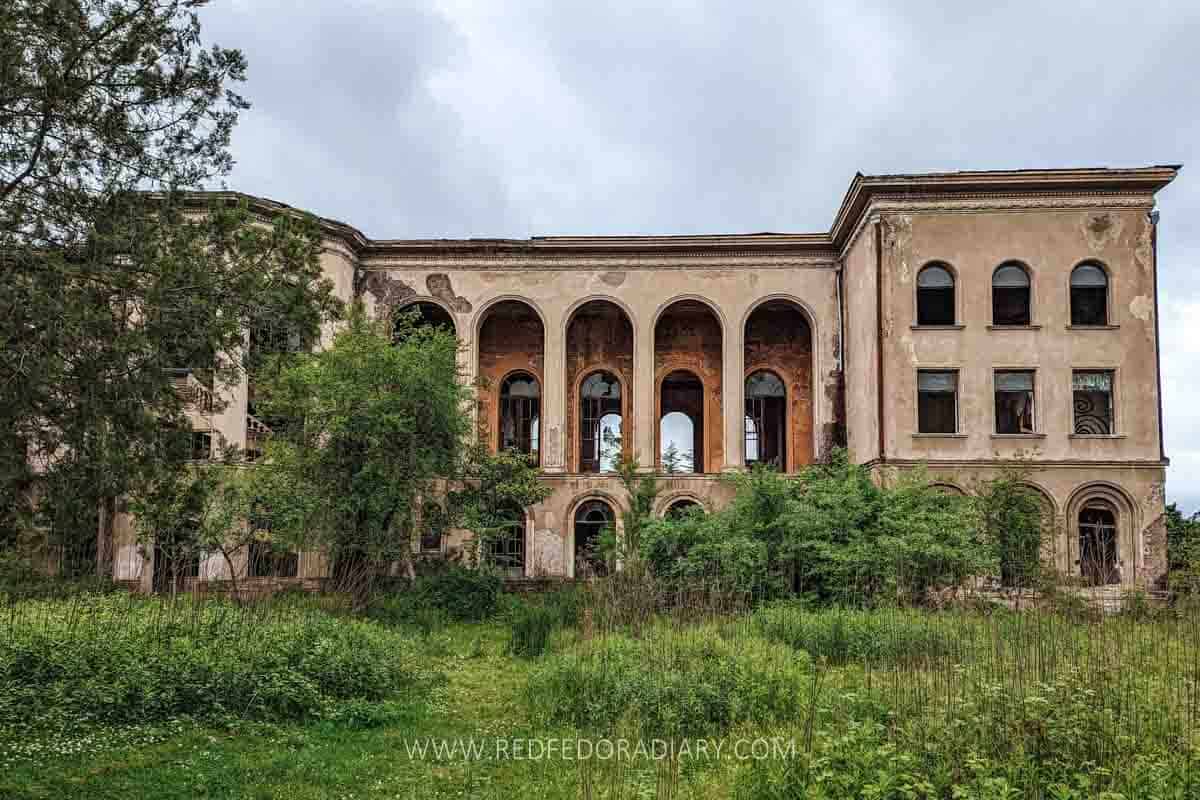
2023 update: sanatorium Imereti is private property now, and the main entrance has a security booth but no fence. The guard was not there during my visit, so I easily walked around the empty building.
Sanatorium Savane
Very close to Imereti, you’ll find another entirely abandoned and grandeur Sanatorium Savane with its semi-circular entrance covered in ivy constructed from 1947 to 1975.
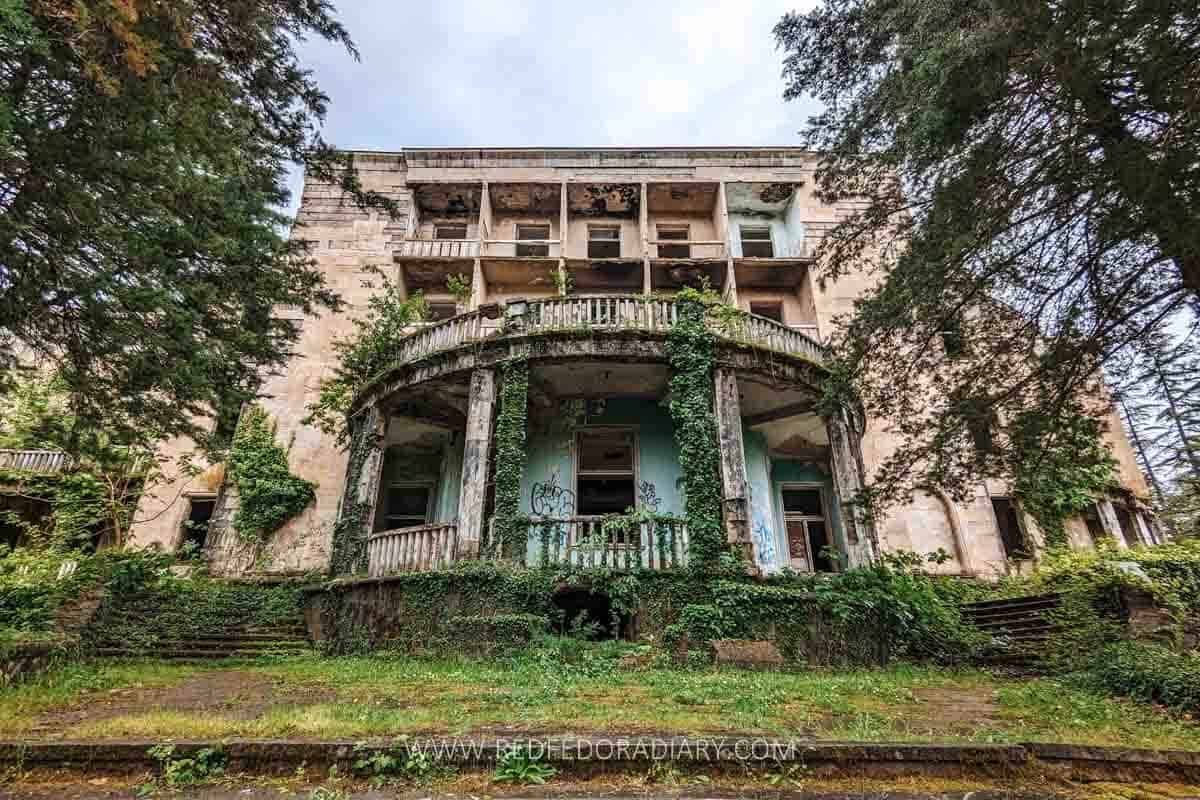
The inside is entirely destroyed, and I don’t recommend going inside as there is nothing much to see. Instead, admire the front facade entry as it’s the most beautiful part of the hotel at this point.
2023 update: Savane was also put on the auction in 2022, but the premises have no fence or guard. It is still in drastic shape, and I don’t recommend entering it.
Tskaltubo Spa Resort
Today’s Tskaltubo Spa Resort was the resort of the Soviet Union Ministry of Defence, meaning that only the employees of the ministry and their families could stay there.
It has undergone partial restoration and, for many years, stands as the only former Soviet sanatorium renovated with modern amenities.
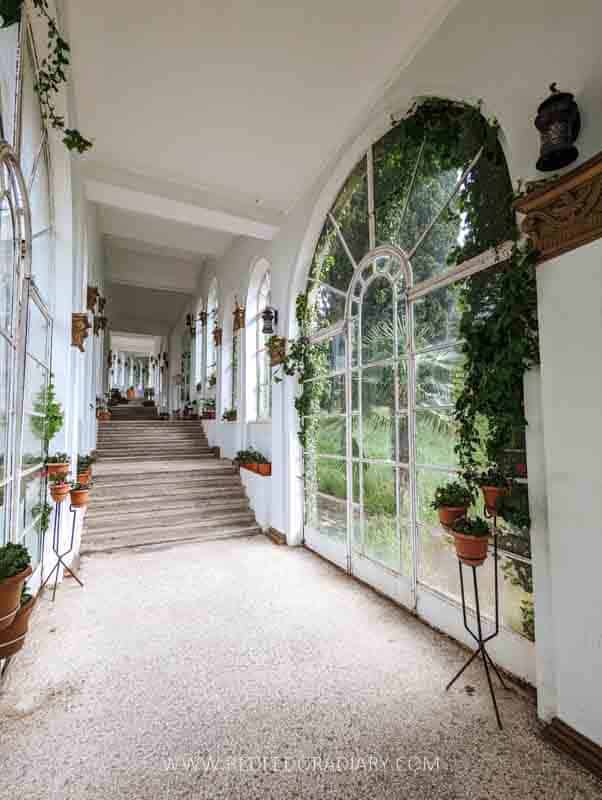
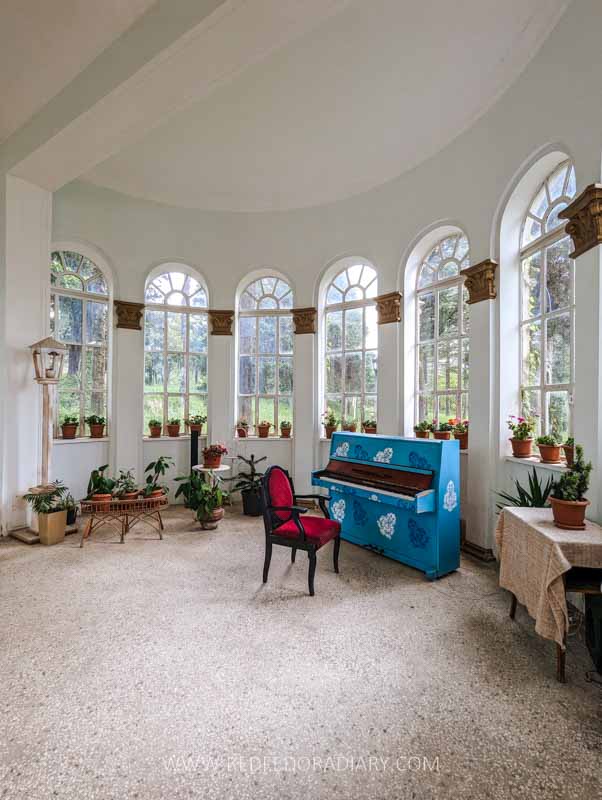
Following extensive renovations to a portion of the property, it reopened its doors in 2011 as a 4-star hotel and a spa center.
The sprawling complex consists of two accommodation wings, connected to a central concert hall and restaurant through covered walkways. While one half has been restored, the other remains untouched, allowing guests to compare and contrast the state of preservation.
You can glimpse Tskaltubo’s once heyday and future potential by staying at the resort. Guests have unrestricted access to the vast 16-hectare property, enabling them to explore the preserved concert hall, a small museum housing Soviet relics, and even Stalin’s suite, which supposedly served as an exclusive retreat for the leader.
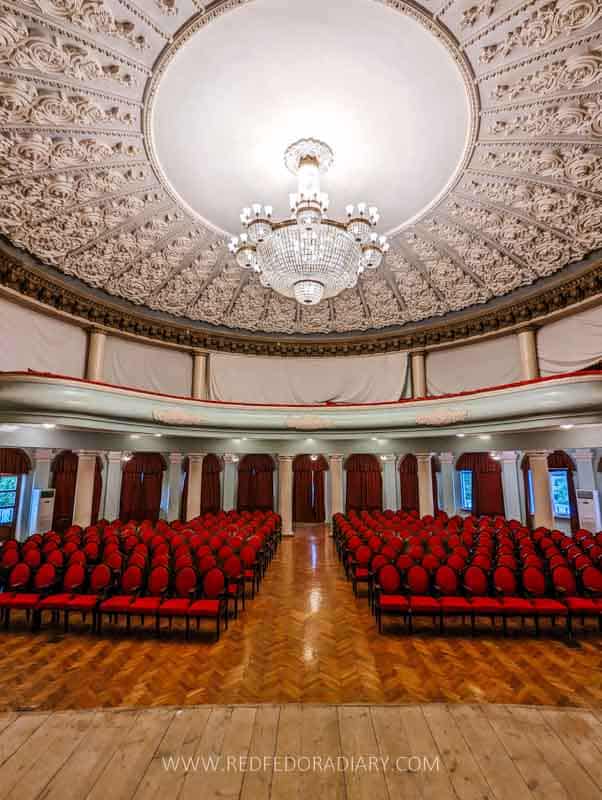
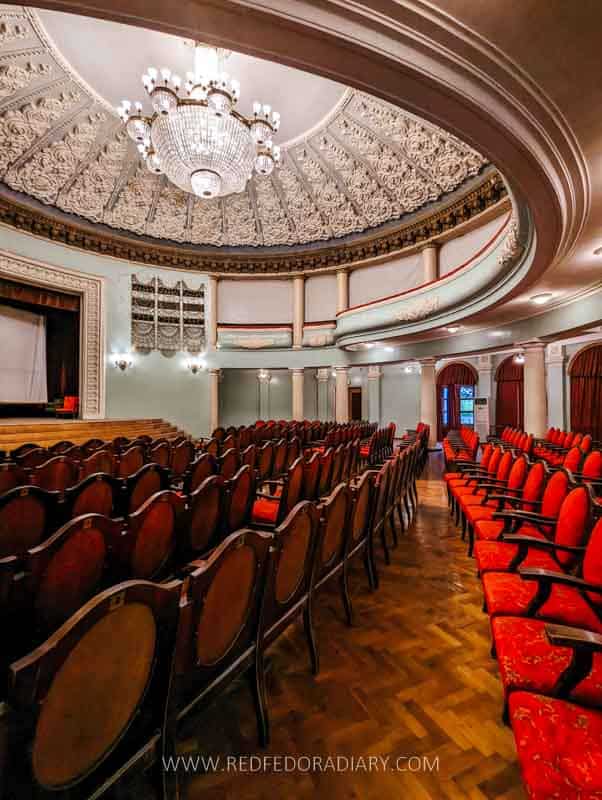
The concert hall is absolutely gorgeous, with the mesmerizing ornate carved ceiling and a giant chandelier suspended in the center. The red chairs pop up against pail mint/baby blue walls. The concert hall even has a circular balcony level.
The covered walkway leading to dining areas is another beautiful spot of Tskaltubo Spa Resort. The Romanesque-style semi-circular big windows are spectacular, opening into a circular foyer at one point before continuing with the corridor.
The room, which used to be a small cafeteria, is now turned into a museum showcasing Soviet-era memorabilia, including someone’s coats and hats hanging on the hanger, various telephones and typewriters, a first aid suitcase, helmets, library cards, and tutorial with pictures on what to do in case of a nuclear attack hanging on the window.
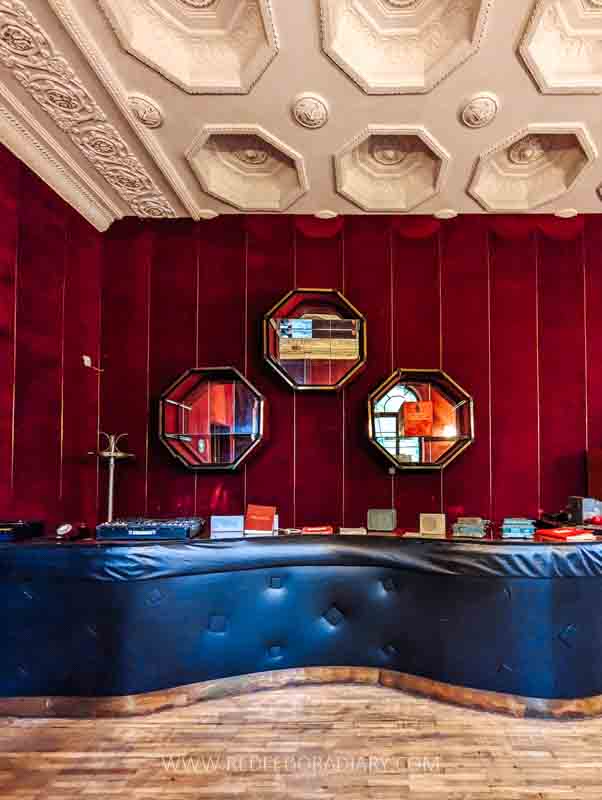
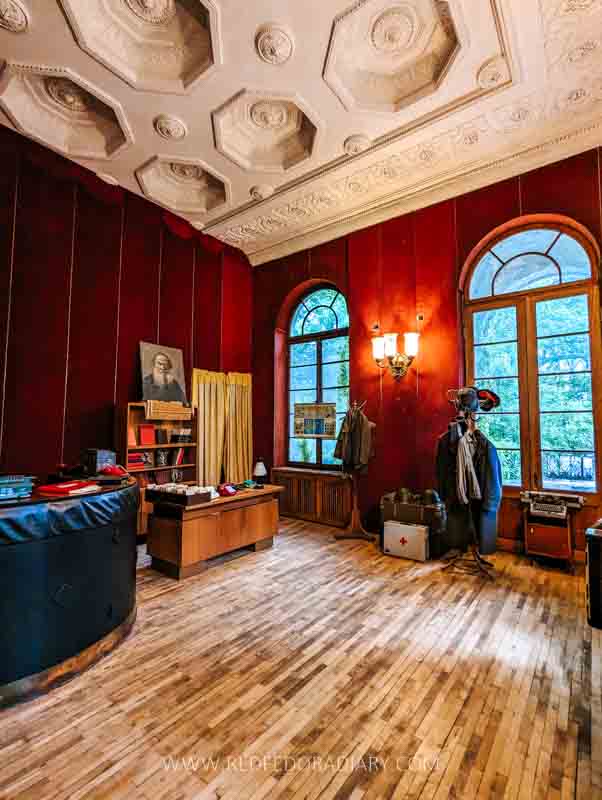
The cafeteria’s entrance still has a textile banner above the entrance door saying in Russian: Glory to May 1st – International Day of Solidarity of Workers.
Stalin’s private room is at unrefurbished part of the resort. When you enter the place, it’s pretty dark on the staircase, and the carpet on the stairs is not correctly mounted, so you need to be careful not to slide and fall.
The room is quite big with a bedroom, living room, and an office with a work desk with access to a balcony. The items are left from that time, so it’s a perfect glimpse of the luxurious furnishings and room decoration of the 1950s.
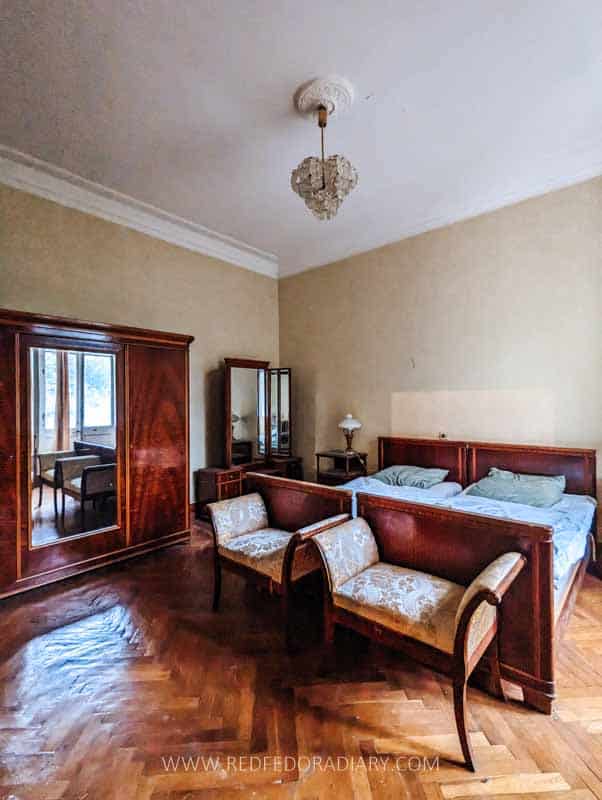
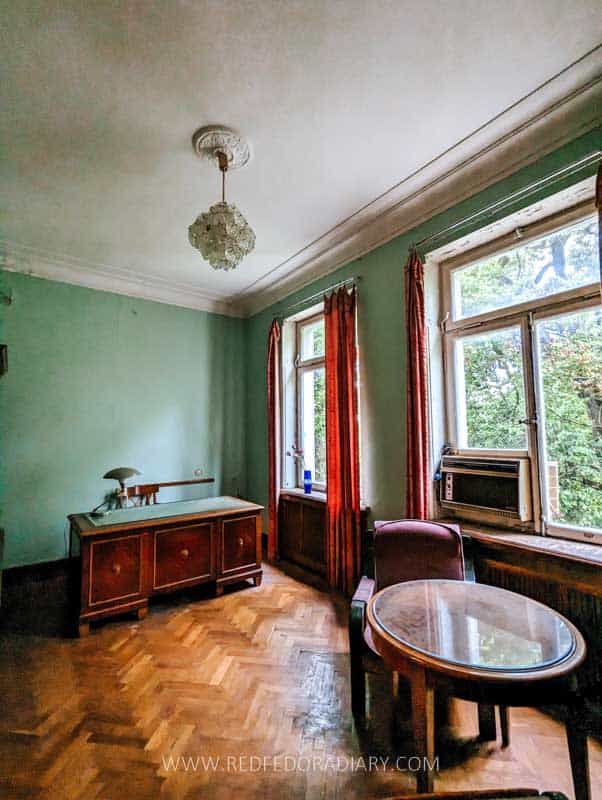
2023 update: you can tour the abovementioned areas (concert hall, small museum, and Stalin’s room) by paying 20 GEL per person. There’s a security guard at the main entrance, and you’d need to tell them you are here to see the rooms. Try saying datvaliereba minda (I want to see) or show them the pictures.
On my visit, when I mentioned the word “tour,” the guard was confused and had to call the head of security, who came to the gate. Luckily, he let me inside easily when I said I wanted to see the place. So don’t give up.
Bring cash to pay at the reception if you can. They have a card terminal, but the receptionist was not pleased when I said I could only pay by card.
Once you pay the fee, someone will be assigned to show you around. Ensure to say you want to see everything I mentioned above – the corridors, cafeteria/museum, and Stalin’s room.
Hotel Aia
The main attraction of the Aia Hotel is the Soviet-time mosaics inside and outside the building. This tall hotel, located on the side streets of the central park, was named after the ancient capital of Colchis and was constructed between 1970 and 1985.
Since the collapse of the Soviet Union, the building was transformed into apartments that became home to several IDP families.
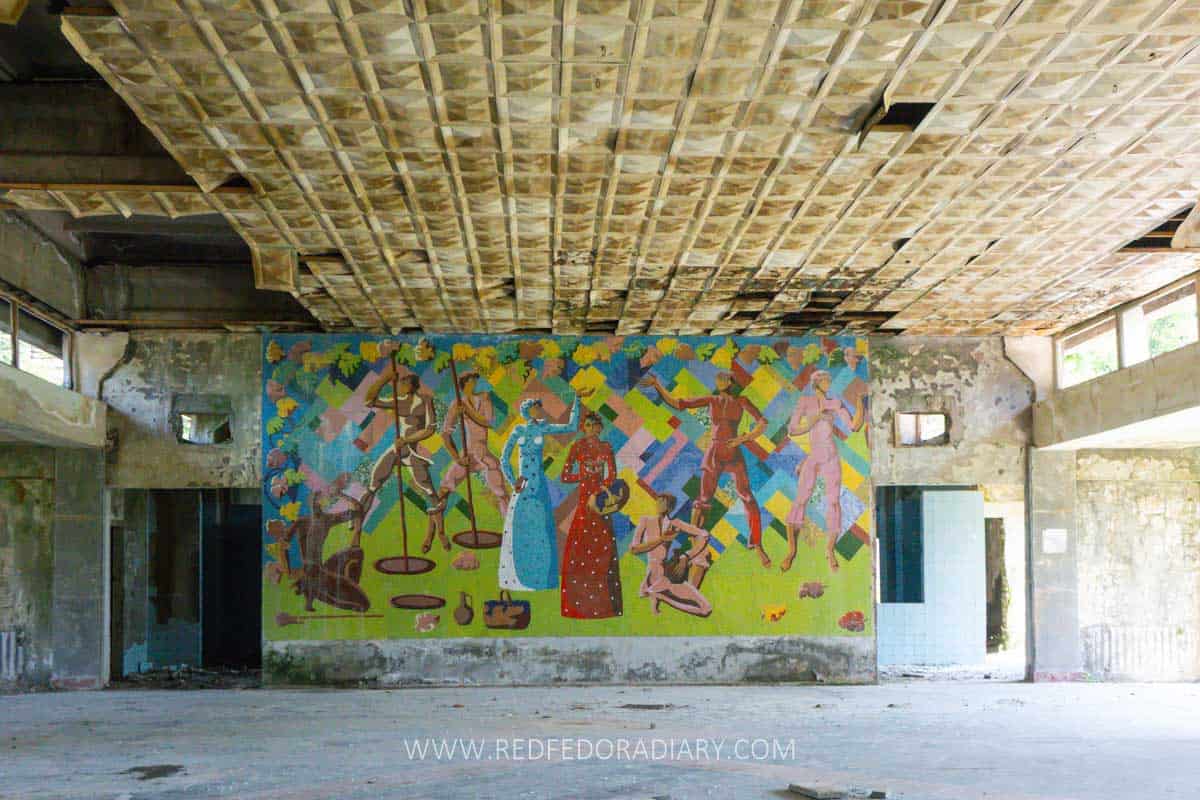
I only walked a small part of its premises to see the wine-themed Soviet-era mosaic in the main hall. Its vivid colors make it easy to see people picking up the grapes and putting them into qvevri for fermentation.
On all my visits to Aia, the condition of the building never bettered, and water constantly drips from the upper floors to the ground. Therefore, similar to Sanatorium Sakartvelo, it’s astonishing to see the mosaic so intact despite the harsh conditions of the building.
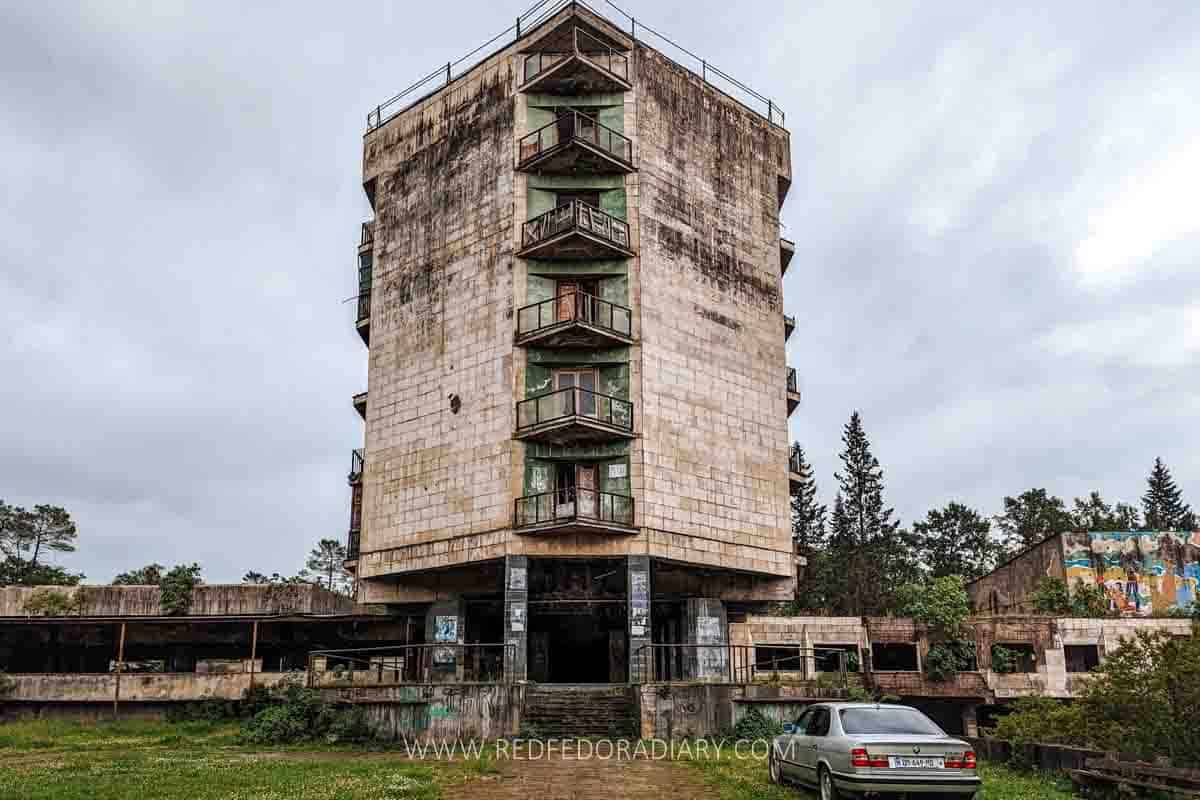
The second mosaic is on the right side of the building, but unlike the one inside, this has been damaged and is partially destroyed. However, you can still identify what’s on the mosaic – people playing on flutes and dancing around.
2023 update: the hotel Aia stands untouched, and both mosaics remain intact.
Bathhouse N6
Bathhouse No 6, now known as Spring 6, remains one of the two functioning spas in Tskaltubo. It’s always busy where people come and go for their treatments.
The exterior facade of the bathhouse is imposing, featuring a striking frieze depicting Stalin above the entrance.
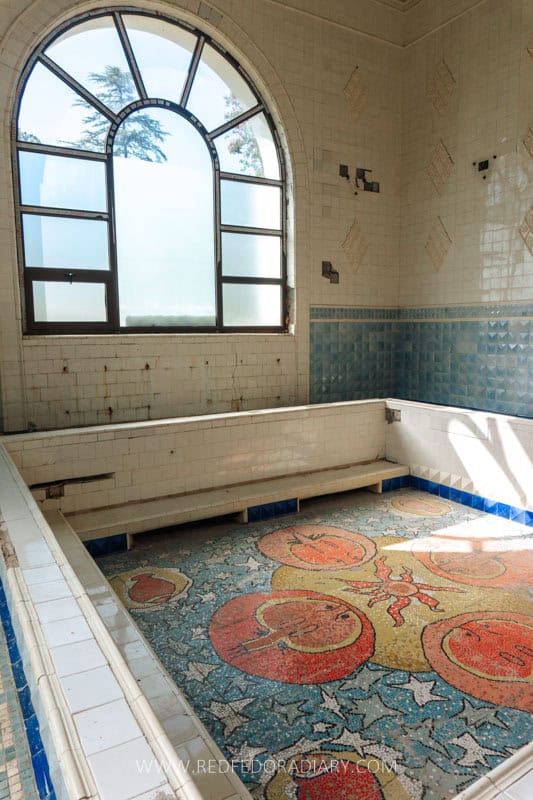
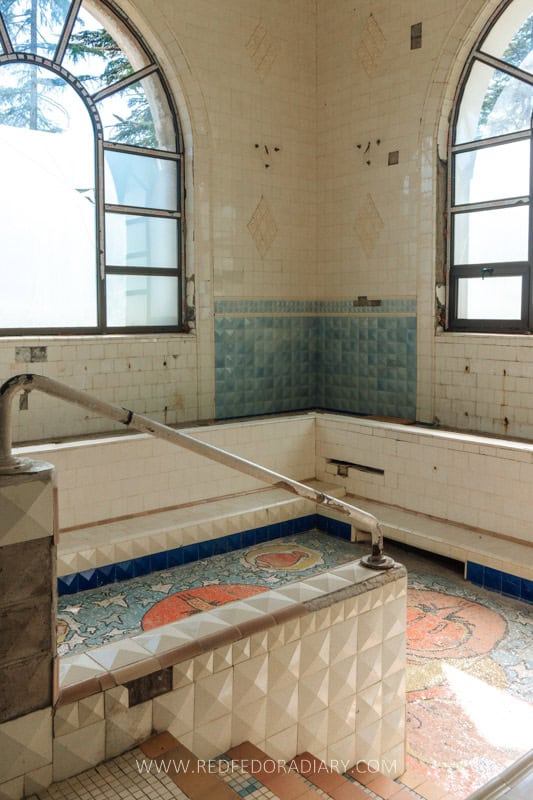
Inside, you’ll find public mineral pools and private baths offering a variety of treatments, some of which are unique.
Notably, Bathhouse No 6 holds significance as Stalin’s bath. His private bathroom, a bright and airy space featuring a large square tub adorned with exquisite horseshoe crab mosaics, has been preserved during the renovations. It remains remarkably unchanged from the time when the leader visited Tskaltubo.
I first saw Stalin’s room as part of a group press trip, but sadly it’s not always guaranteed you’ll be allowed to enter or not. Nevertheless, it is worth asking permission; you are already there and have nothing to lose.
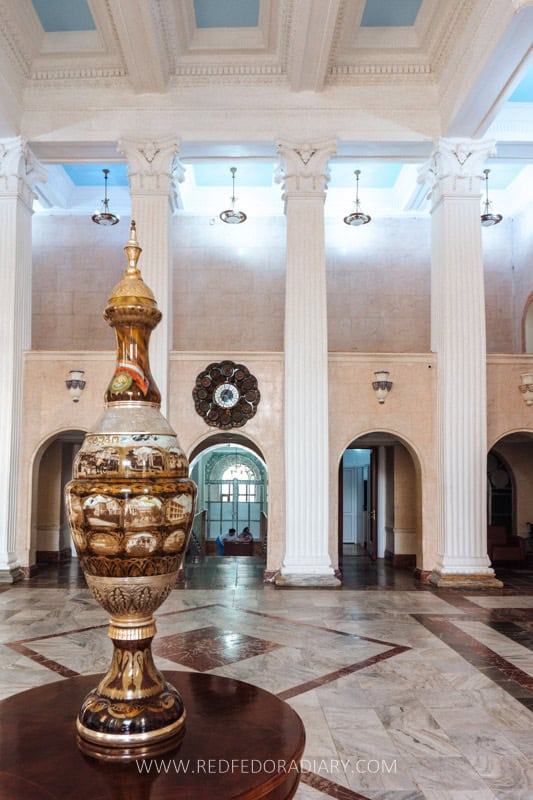
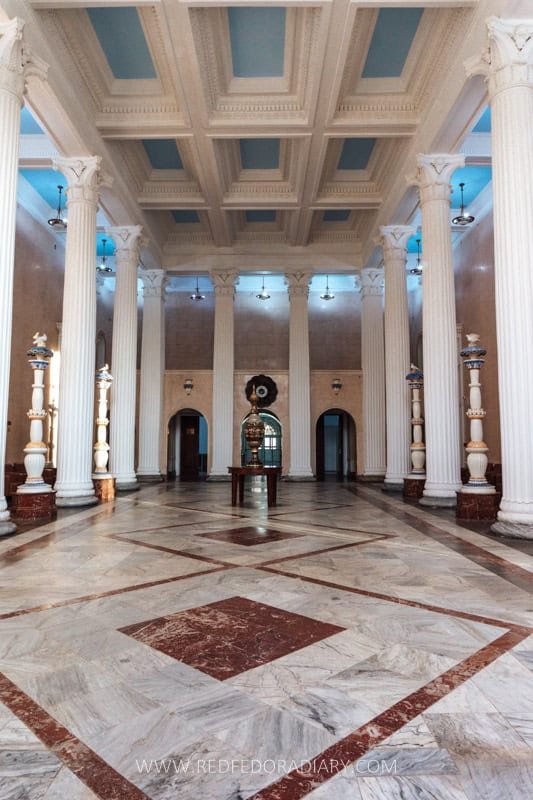
Even if they won’t let you see the famous room, take a moment to look around the reception area adorned with a massive vase that has tiny photos of Tskaltubo in its heyday.
Bathhouse N8
This is my favorite bathhouse of them all. It is an iconic structure with a unique exterior.
Abandoned and covered in foliage, you might even miss it if you don’t know where to look. Located close to the N6, Bathhouse N8 was constructed in 1959.
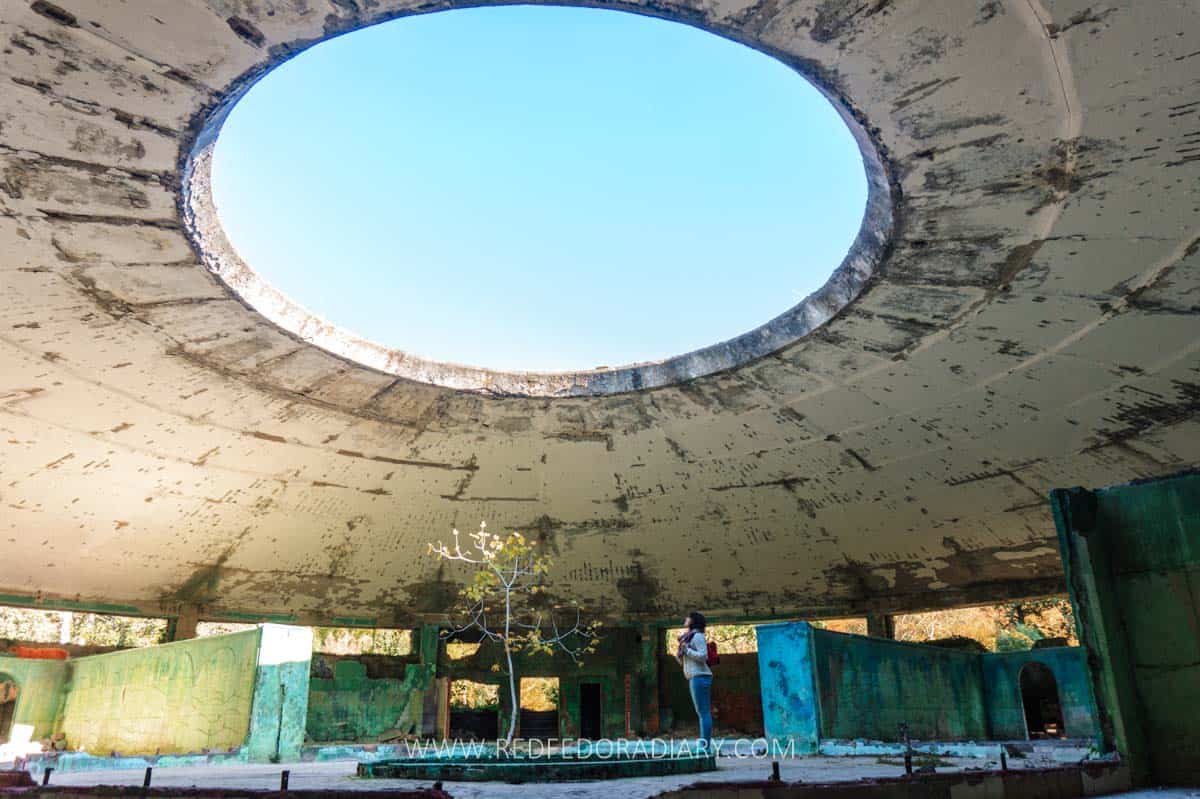
It has a dome-shaped roof made from iron-cement construction that weighs around 42 tons. It was the first of such kind of construction made at that time and served as a test drive to the roofing of Tbilisi Sports Palace.
The bathing area comprises clusters of pod-shaped systems resembling blooming flower petals encircling a central fountain. The dividing walls of these bathing areas have traces of decorations showcasing a dear.
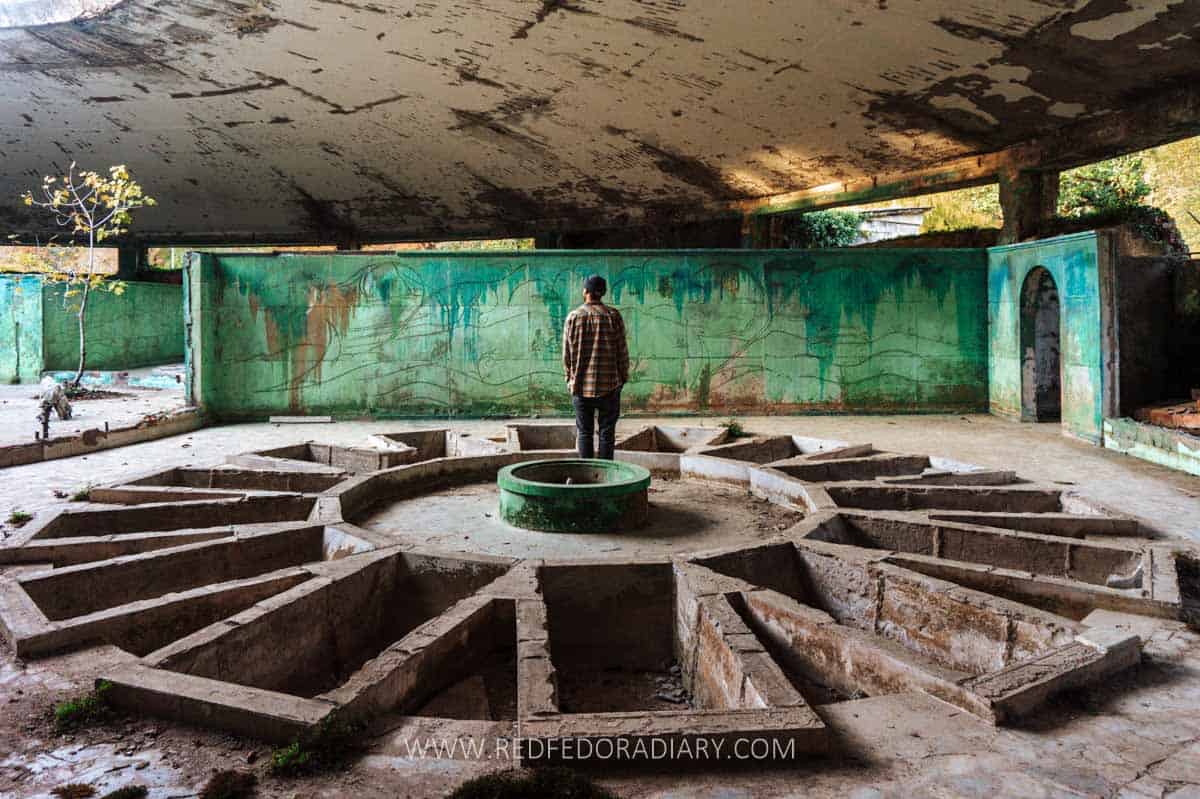
Abundant sunlight streams through a large circular opening in the roof, creating an inviting ambiance. The tree in the middle adds a unique charm to the place.
The bathhouse features four entry points, easily accessible within the park. Sadly, the interior is full of garbage and waste and sometimes smells funny.
Bathhouse N5
Another entirely abandoned bathhouse worth checking out; however, note that it’s in terrible shape, and the smell in some parts is quite strong.
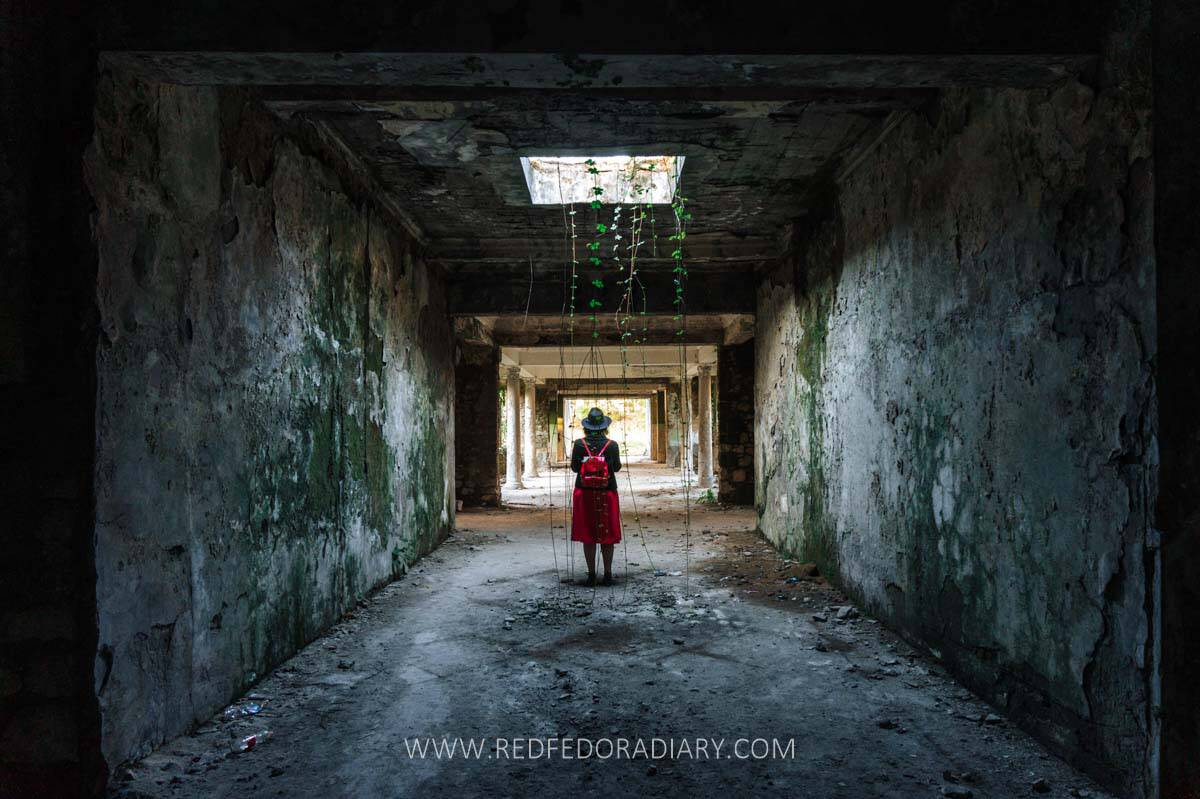
I couldn’t find much information about this bathhouse, but from what I saw in its crumbling walls, it must have been significant and beautiful with yellow-tiled baths.
Other things to do in Tskaltubo
Marvel at Tskaltubo Railway Station
As vacationers disembarked from the train bringing them to Tskaltubo, the railway station was the first sight that greeted them.
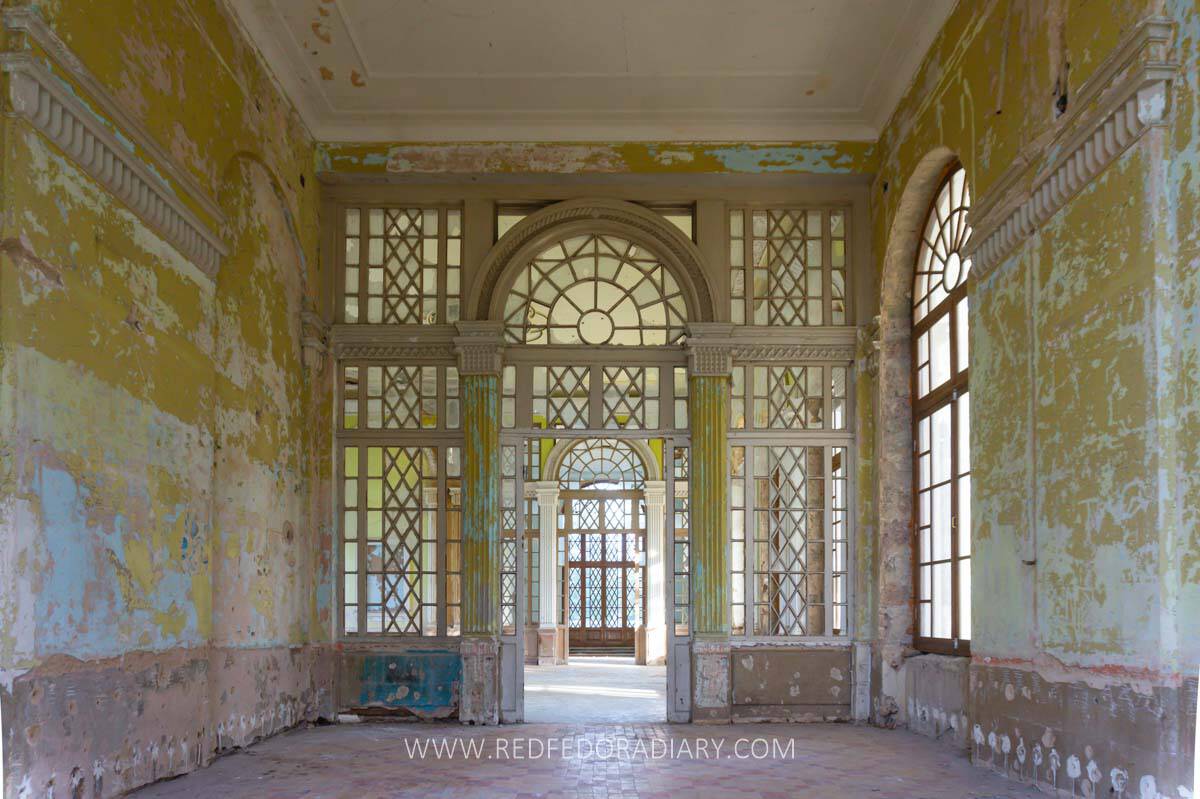
It indeed is a magnificent cream stone structure that oozes a sense of grandeur.
However, once bustling with activity, the platforms are now forgotten and overgrown, as the station ceased operations decades ago. When I visited Tskaltubo for the second time in 2019, locals told me that a Kutaisi-Tskaltubo train still operated twice daily, which seems no longer valid.
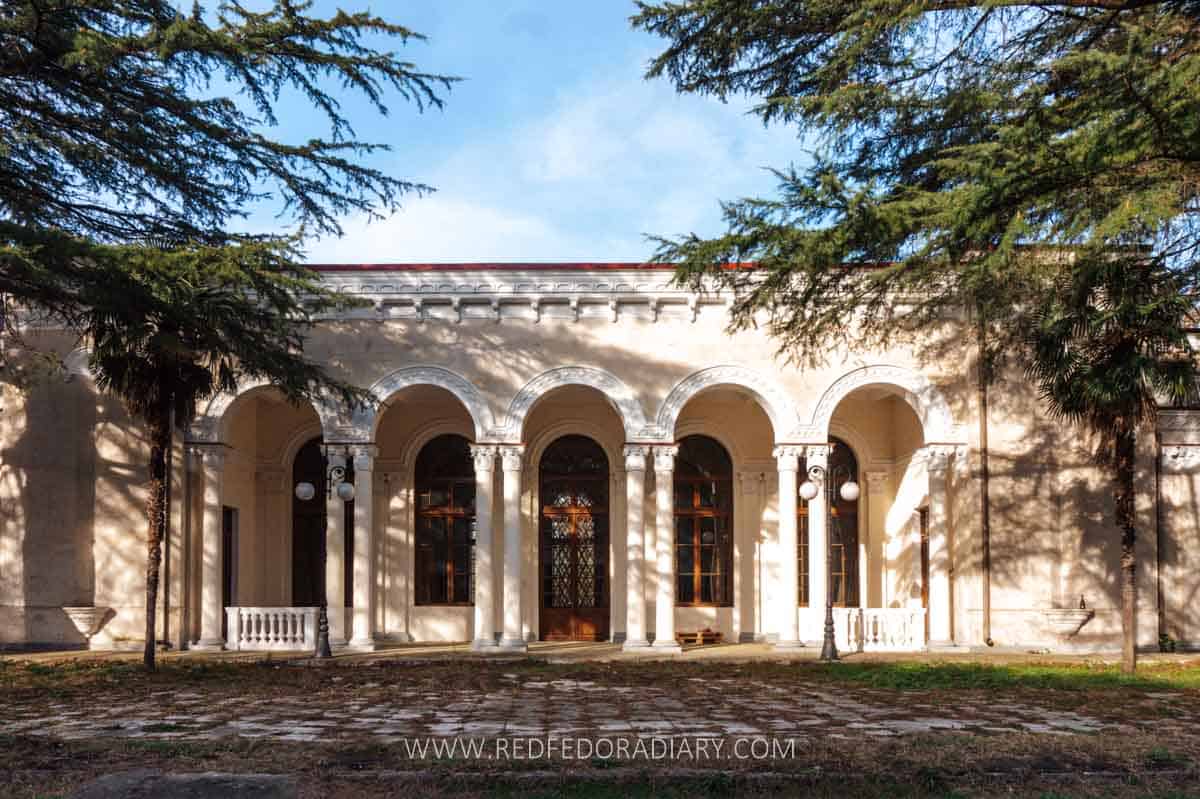
The building’s ground floor housed a tourist information center for a brief period, but after their relocation, it returned to its state of abandonment.
Explore Stalin’s Dacha
Dacha is a Russian word referring to a holiday cottage. Even though he might have visited Tskaltubo several times, he built a house perched on a hilltop overlooking Tskaltiubo. As a side note, many dachas or buildings are attributed to Stalin in Georgia, including the one in Racha.
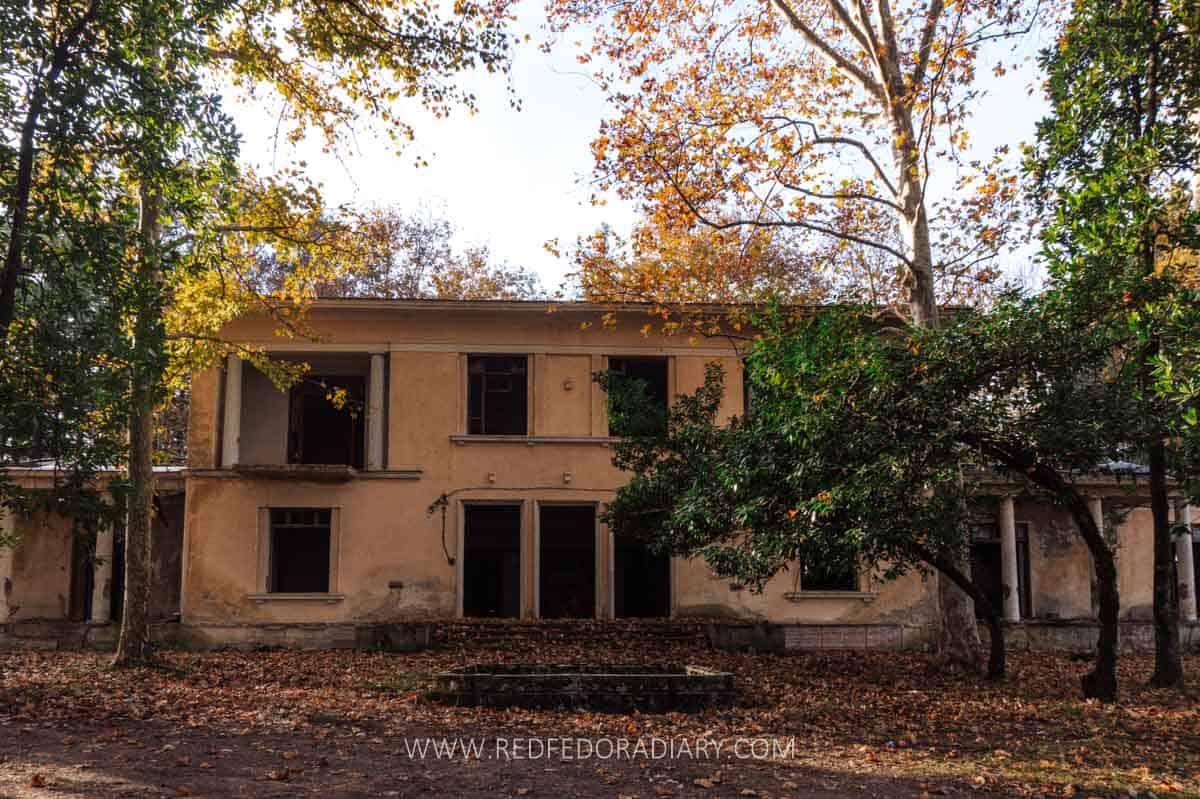
It’s a fascinating complex to explore, located a bit far from the Tskaltubo center. It’s a vast area full of abandoned buildings that might have been used for various purposes by staff members.
It is also possible that KGB had its own “sanatorium” within the territory to guard the place, making it impossible for anyone without a special pass to enter the property.
The cottage is nothing special and seems relatively modest regarding beauty or architectural significance. Tourism Information Center told me that the whole complex was built very quickly, but Stalin only stayed here once. And rumor has it that he even had a favorite spot to sit down and look over Tskaltubo from above.
Visit karst cave
Tskaltubo attracts numerous visitors who embark on day trips from Kutaisi to explore the renowned Prometheus Cave. This karst cave boasts an abundance of stunning stalagmites and stalactites, brought to life by vibrant illuminations.
As one of the largest caves in Georgia, its grandeur captivates all who venture within. However, only a limited portion of approximately 1.2 kilometers of pathways is accessible to tourists, allowing them to marvel at its natural wonders.
Relax at Tsivi Tba
Tsivi Tva, translated as the Cold Lake, is a small lake close to Sanatorium Iveria and a nice place to have a relaxing walk in the evening. It’s a popular recreational area for locals. There’s also a restaurant serving Georgian and European meals. During the season, you can even rent a boat.
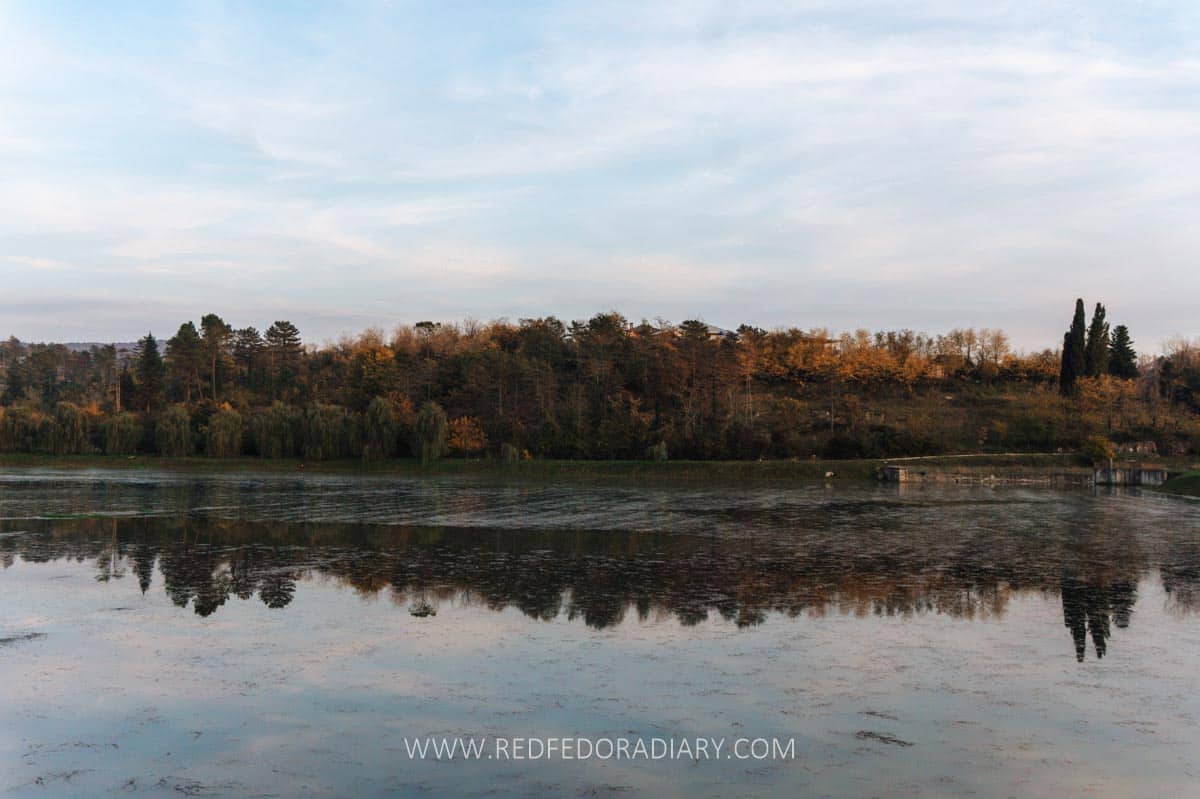
Where to stay in Tskaltubo
There are several guesthouses and hotels in Tskaltubo to stay. There are a few near the central park and to former sanatoriums, but some fit further into the town. I personally always stay in Kutaisi and make day trips to Tksaltubo, but if you decide you want to spend a night, here are the hotels I recommend:
Tskaltubo Spa Resort: This 4-star hotel that once was a grand sanatorium offers a unique experience in its comfortable rooms and a range of amenities.
Tskaltubo Plaza Hotel: Situated mere 300 meters from Tsivi Tba and conveniently across from the renowned thermal baths, the hotel provides a delightful stay with well-appointed rooms equipped with modern amenities,
Park Hotel Tskaltubo: is another centrally located hotel with a spa center and a wide array of mineral water treatments. Each room at the hotel is thoughtfully adorned in warm colors.
→ Can’t find something that suits your taste? Here are more hotels in Tskaltubo.
If you’ve visited Tskaltubo after May 2023 update of this post and see something has changed, I’d appreciate you commenting below.
My Favorite Travel Resources
To ease your travel planning, check out all the posts about Georgia travel. Additionally, here are some of the websites and services I use when preparing for my next adventure anywhere in the world.
✈ Book affordable flights on WayAway, a platform that shows the best flight deals, tours, and hotels. With a WayAway Plus membership, you can earn cashback. Get 10% off with code: RFD10
🚫 Get compensation for up to 700$ with Airhelp if your flight was canceled or delayed within the last 3 years.
🚗 Rent a car at Local Rent for affordable prices and convenient service.
❣ Pre-book a private car transfer with GoTrip from Tbilisi Airport to your hotel or any other city across Georgia.
💻 Get a VPN from Surfshark to protect your devices from hackers when using public Wi-Fi when traveling.
📱 Install the Airalo app, which provides local eSIMs for a more affordable internet connection when traveling. Get 3 USD with code: BAIA2592.
💸 Use Wise to withdraw money in local currency without hidden fees and avoid high exchange rates. On top, you might get a Visa or Mastercard debit card.
🍷 For some of the best, expat-designed wine tours check out Eat!ThisTours. Get a 5% discount with code RFD5.
🏨 Find budget-friendly deals on all sorts of accommodation types on Booking.com.
🩺 Buy the most flexible and budget-friendly travel insurance, SafetyWing, covering COVID.
☀ Book in advance some of the best city walks, cultural experiences, and day tours to maximize your stay and experience here.
